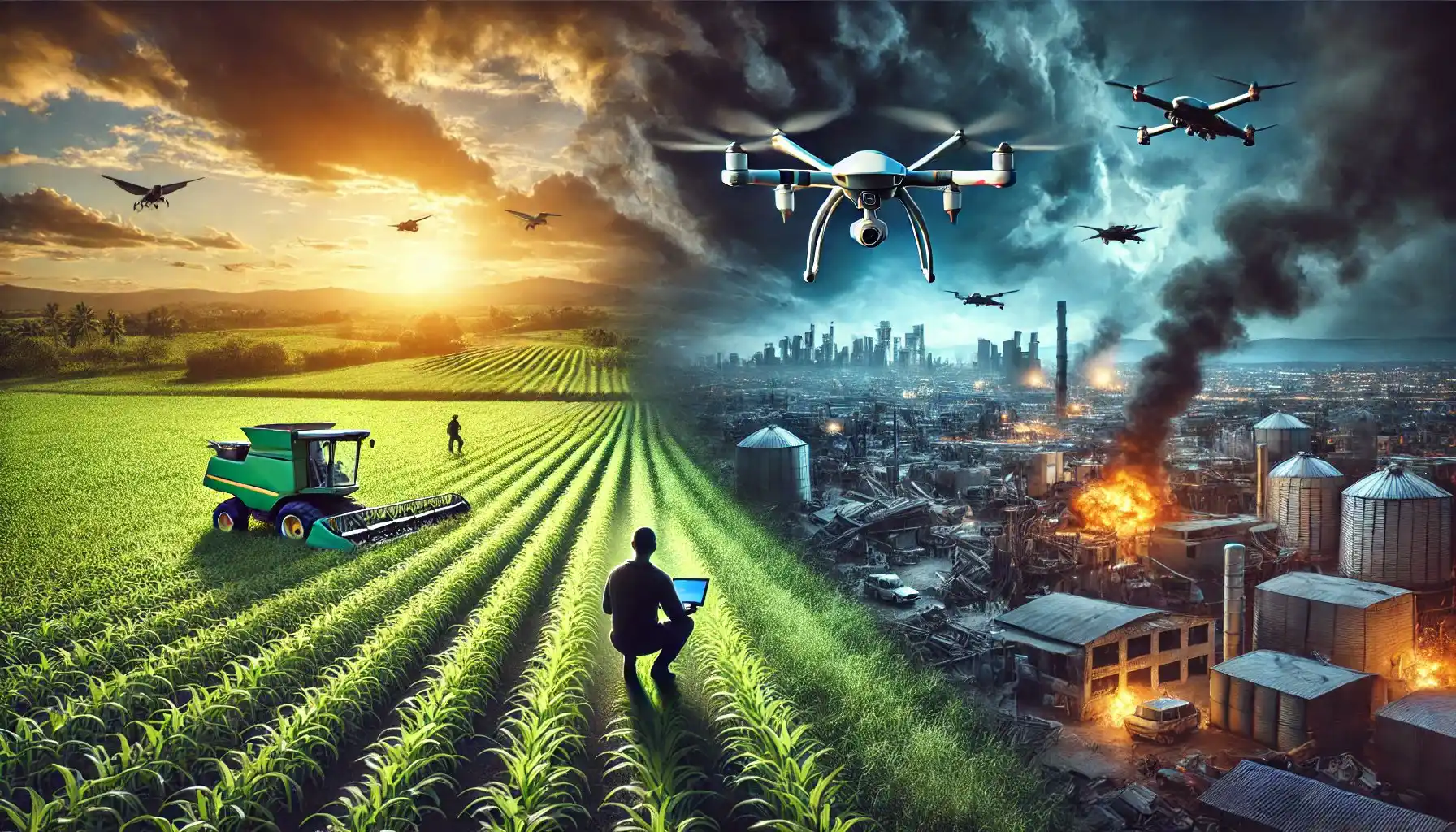Part 1: Introduction
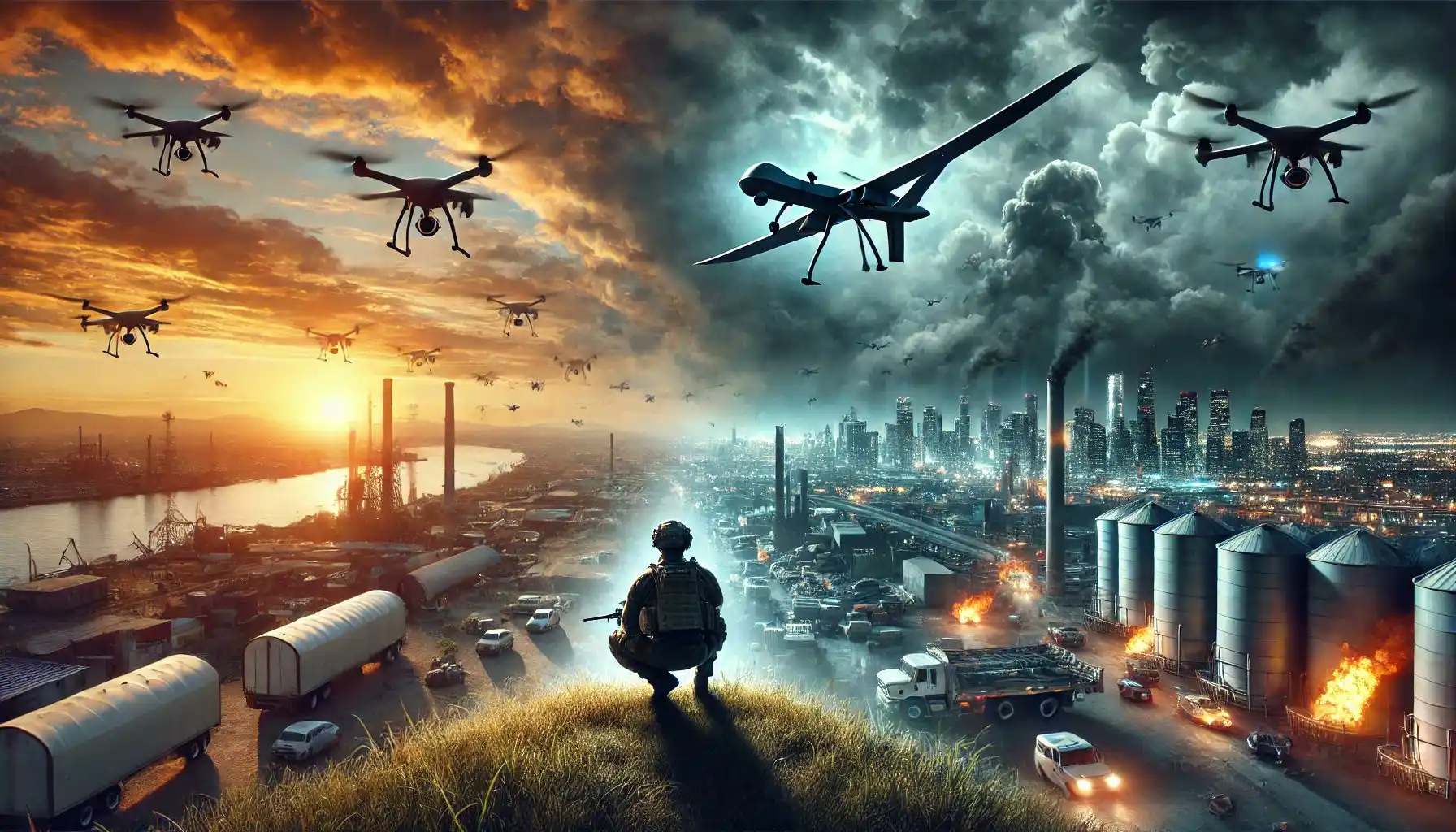
1.1. The New Battlefield
The hum of a drone slicing through the air was once a symbol of curiosity and progress. It represented a world on the cusp of technological marvels — machines designed to bring distant landscapes into view, to map uncharted territories, and to connect people in ways previously unimaginable. These aerial devices were tools of exploration, artistry, and efficiency, transforming human imagination into tangible reality.
Yet, technology, like fire, is a double-edged sword. It is indifferent to intent, serving equally in the hands of creators or destroyers. Over the past decade, drones have morphed from benign instruments of exploration into weaponized specters — agents of surveillance, control, and violence. Once synonymous with breathtaking vistas and rapid delivery, drones now evoke unease. They scout, they spy, and, in many instances, they kill.
The battlefields of the 21st century are unrecognizable compared to those of the past. Gone are the trenches and defined frontlines. Today’s wars are fought in the skies above, where machines silently hunt their prey, guided by invisible operators or sophisticated algorithms. The appearance of a drone is no longer a benign curiosity. For many, it is a harbinger of danger — a chilling reminder that modern warfare can breach even the most personal spaces, blurring the lines between combat zones and civilian life.
1.2. The Changing Face of Conflict
Throughout history, warfare has evolved alongside the tools of its execution. The bow and arrow gave way to firearms, and tanks replaced cavalry. But the drone is unprecedented. It is accessible, adaptable, and often invisible — a weapon that democratizes conflict. The battlefield is no longer limited to borders or defined zones; it exists wherever the sky is visible.
In military contexts, drones act as force multipliers, enabling real-time intelligence gathering, precision strikes, and surveillance — all while sparing human soldiers from direct risk. But the same capabilities that enhance military operations can, and often do, fall into dangerous hands. When these tools are used against civilians, urban infrastructure, or critical industries, the implications are sobering. Invisible threats now permeate the skies, capable of monitoring, disrupting, and destroying with impunity.
1.3. The Drone’s Expanding Reach
It is not only militaries that wield drones. Terrorist groups, criminal networks, and lone actors have embraced their versatility. Drones smuggle contraband across borders, surveil high-security facilities, and, in extreme cases, deliver lethal payloads. Their affordability and accessibility lower the barriers to misuse, making them a growing menace.
Even outside conflict zones, the proliferation of drones raises significant concerns. Unauthorized surveillance, privacy violations, and the risk of accidents in crowded airspaces are no longer hypothetical scenarios but frequent realities. The question is no longer whether drones will be misused — it is how prepared we are to confront and mitigate their misuse.
1.4. A Call to Action
For every emerging threat, there must be a corresponding response. The skies, long considered neutral territory, are now contested spaces. Those who understand the gravity of this transformation have a responsibility to act — to reclaim control of the skies and ensure that they do not remain the sole domain of those with malicious intent.
This book is not merely a guide; it is a call to arms. It acknowledges that drone defense is no longer optional but essential. Whether you are a soldier, a security professional, or a concerned civilian, the knowledge contained within these pages is your first line of defense.
Together, we will chart the evolution of the drone threat, from its humble origins to its weaponized present. We will examine the tools and tactics necessary to counter this airborne menace, blending traditional approaches with innovative technologies. And we will look to the future, anticipating how preparation and adaptation can outpace a rapidly evolving adversary.
The battlefield may now lie above us, but the battle is ours to win. With insight, preparation, and determination, the skies can once again become a realm of wonder — not fear. The journey to reclaim the skies begins now.
2. The Rise of the Drone Threat
2.1. Drones: A Revolutionary Beginning
Drones: A Revolutionary Beginning Drones, once a symbol of technological promise and human ingenuity, have become an indispensable part of our world. Small, agile, and highly adaptable, they initially captured public fascination as tools of convenience and innovation. They charted uncharted terrain, brought lifesaving supplies to remote locations, and captured awe-inspiring vistas from above. Yet, like any transformative technology, their evolution has carried unintended consequences. What began as instruments of discovery have become instruments of destruction, reshaping civilian life and modern battlefields alike.
2.2. From Tools of Progress to Weapons of War
Drones’ early applications were heralded as breakthroughs across industries. Farmers used them to monitor crops, filmmakers created dynamic aerial shots, and governments deployed them for disaster response. Their autonomy and efficiency seemed boundless. However, their potential for misuse soon became apparent. Militaries led the way in re-purposing drones, using them initially for surveillance before rapidly progressing to weaponized platforms capable of precision strikes.
By the early 2000s, military drones like the Predator UAV revolutionized warfare. Capable of providing real-time intelligence and delivering precision-guided munitions, they extended the battlefield into the skies. Unlike traditional air support, drones could linger over targets, striking at the opportune moment without risking pilots’ lives. The implications were profound: drones democratized the ability to wage war, breaking down barriers for state and non-state actors alike.
2.3. Modern Applications
Utility and Menace Today, drones fulfill an array of roles across civilian and military domains, ranging from mundane tasks to sophisticated operations. Their adaptability has made them indispensable but also dangerous.
1. Surveillance: Equipped with high-resolution cameras, infrared sensors, and even facial recognition, drones are unparalleled tools for reconnaissance. They monitor enemy movements and track individuals with precision, offering near-omniscient observation capabilities.
2. Delivery Systems: While civilians marvel at drones delivering packages or medical supplies, these same systems can deliver lethal payloads. Insurgent groups and criminal networks have adopted drones for smuggling and targeted attacks.
3. Weaponized Platforms: Armed drones have leveled the playing field in asymmetric warfare. Their precision strikes eliminate the need for direct confrontation, making them a cost-effective tool for smaller adversaries to challenge larger powers.
2.4. Drones in Action: Real-World Case Studies
Examining recent conflicts highlights the dual-edged nature of drones as both enablers and disruptors:
- ISIS’s Improvised Drones: In Iraq and Syria, ISIS turned commercial quadcopters into weapons of terror. By modifying off-the-shelf models to carry grenades, they created a low-cost yet highly effective tool to disrupt enemy forces. These tactics showcased the dangers of accessible drone technology in unconventional warfare.
- The Ukraine Conflict: Drones have played a pivotal role in the war in Ukraine, used extensively by both sides for reconnaissance and direct strikes. Kamikaze drones have targeted infrastructure, while reconnaissance UAVs guide artillery with chilling accuracy.
- Civilian Disruption: In 2018, unauthorized drones grounded flights at London’s Gatwick Airport for days, demonstrating the potential for even unarmed UAVs to wreak havoc in civilian life.
2.5. Implications of Drone Proliferation
The rise of drones has transformed not only warfare but the nature of global security challenges. Their widespread availability and adaptability blur the lines between combatants and civilians, creating an urgent need for robust countermeasures.
1. Lowering the Barriers to War: Drones are affordable, widely available, and easily modified. Even a hobbyist device can become a tool of war, enabling lone actors and smaller groups to challenge powerful adversaries.
2. Asymmetric Power: By enabling precision strikes from a safe distance, drones empower insurgents and non-state actors, giving them a disproportionate impact in conflicts.
3. Psychological Impact: The persistent hum of a drone overhead creates fear and unease, amplifying the psychological toll on soldiers and civilians alike.
4. Public Security Challenges: Beyond warfare, drones pose risks to critical infrastructure, privacy, and civilian safety. The potential for misuse in densely populated areas adds an alarming dimension to the threat.
2.6 A Call to Action
The drone threat is neither hypothetical nor distant — it is here, evolving rapidly and demanding immediate action. Countering this airborne menace requires an informed, proactive approach. From military strategists to concerned civilians, everyone has a role in reclaiming control of the skies.
This book is not just an analysis but a guide and call to arms. It explores the evolution of drones from innovation to threat, dissects their capabilities, and offers strategies to combat them effectively. Together, through preparation and determination, we can ensure the skies remain a space of possibility, not peril. The journey to reclaim them begins here.
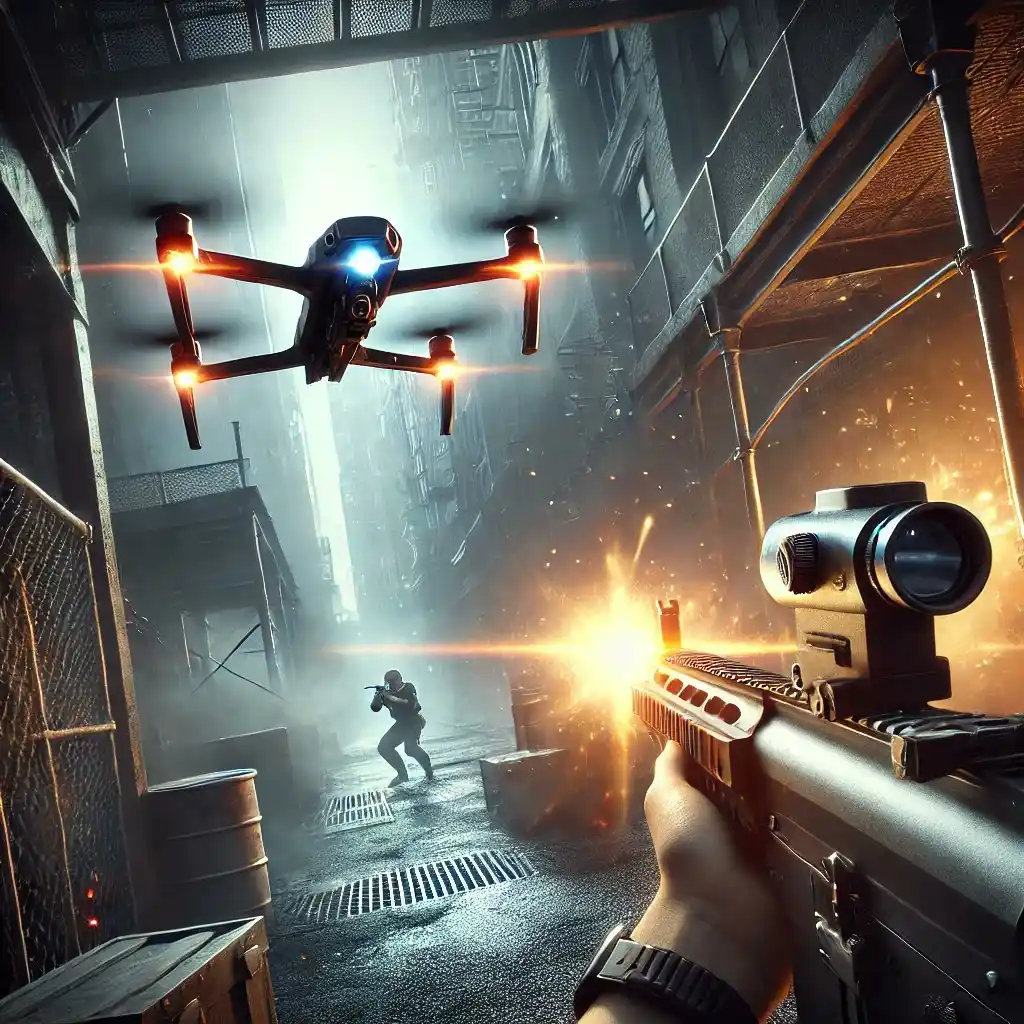
3. Weapons of Choice
In the battle to reclaim control of the skies, your choice of weaponry is not a mere preference — it is a matter of strategy, precision, and understanding the nature of the threat. The tools of drone defense vary as widely as the threats themselves. From small, nimble quadcopters to large, heavily armed UAVs, each type of drone demands a tailored response. In this chapter, we explore the essential weapons in a defender’s arsenal, delving into their strengths, limitations, and the tactics that maximize their effectiveness.
3.1. The Shotgun: Your Close-Range Guardian
Imagine a fast-moving quadcopter darting unpredictably through urban airspace. Its speed and agility render traditional firearms almost useless. Enter the shotgun — a weapon designed for moments like these, where close-range precision and adaptability are critical.
The shotgun’s broad pattern and stopping power make it the most reliable choice against small drones. Its design compensates for erratic movements, delivering disabling hits even with minimal accuracy. Whether in urban settings or confined spaces, a shotgun provides defenders with a decisive edge.
3.1.1. Why the Shotgun Excels
The shotgun’s ability to spread multiple projectiles in a cone-shaped pattern ensures a higher probability of hitting small, agile drones. Even a glancing blow can destabilize lightweight frames, grounding the drone and neutralizing its threat. This versatility is why the shotgun remains indispensable in the modern aerial battlefield.
3.1.2. Choosing the Right Ammunition
Your ammunition choice significantly impacts the shotgun’s effectiveness. The two primary options include:
- Birdshot: Ideal for fragile drones, birdshot disperses a dense cloud of tiny pellets, maximizing hit probability. Its effectiveness diminishes beyond 25 – 50 meters, but within its range, it is unmatched.
- Buckshot: Designed for greater stopping power, buckshot fires larger pellets, making it suitable for sturdier drones or targets slightly beyond the range of birdshot.
Tactical Applications
Shotguns are most effective in the following scenarios: - Close-Range Defense: Within 50 meters, the spread pattern ensures coverage of fast-moving targets.
- Small Drone Engagements: Perfect for quadcopters or similar UAVs with minimal structural integrity.
- Urban Settings: The reduced risk of collateral damage makes shotguns a safer option in populated areas.
For added versatility, consider under-barrel shotgun attachments, such as the M26 Modular Accessory Shotgun System (MASS). These hybrid solutions allow defenders to transition seamlessly between precision rifles and close-range shotguns without changing weapons.
3.1.3. Tactical Applications
-
Close-Range Defense: Within 50 meters, the spread pattern ensures coverage of fast-moving targets.
-
Small Drone Engagements: Perfect for quadcopters or similar UAVs with minimal structural integrity.
-
Urban Settings: The reduced risk of collateral damage makes shotguns a safer option in populated areas.
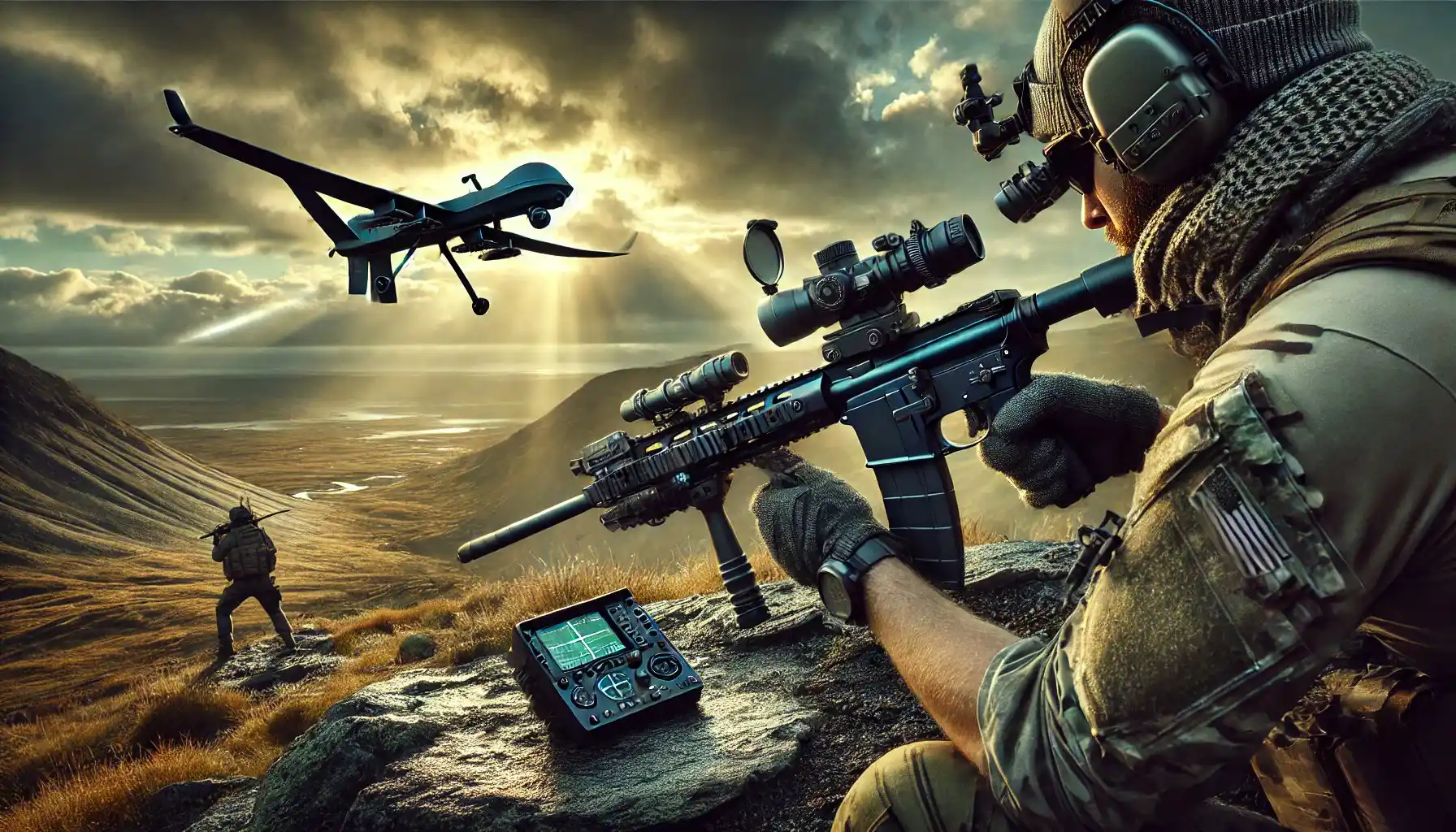
3.2. The .308 Battle Rifle: Precision Meets Power
When threats extend beyond shotgun range or involve medium-sized drones, the .308 battle rifle becomes the weapon of choice. Its combination of accuracy, power, and range makes it the ideal tool for engaging UAVs that operate at greater distances or exhibit moderate structural integrity.
3.2.1. The Power of the .308 Cartridge
The .308 cartridge delivers significant kinetic energy, capable of neutralizing drones with a single well-placed shot. With an effective range of up to 600 meters, this rifle allows defenders to engage targets from a position of safety. By targeting critical components — such as rotors, sensors, or payload compartments — defenders can effectively disable UAVs before they reach their objectives.
3.2.1 Semi-Automatic vs. Bolt-Action
- Semi-Automatic Rifles: Models like the AR-10 or SCAR-H excel in scenarios requiring rapid follow-up shots, making them ideal for multiple or fast-moving targets.
- Bolt-Action Rifles: Known for superior accuracy at extreme ranges, bolt-action rifles are better suited for stationary or slow-moving drones in open environments.
3.2.2. Optimizing Performance with Optics
Equipping your rifle with appropriate optics is essential:
- Low-Power Variable Optics (LPVO): Ideal for medium-range engagements, these scopes provide quick target acquisition without sacrificing situational awareness.
- Thermal Imaging Scopes: Effective for detecting drones in low-light conditions or when visual camouflage is employed.
- Laser Rangefinders: Ensure precision by calculating exact distances to the target.

3.2.2. Heavy-Caliber Weapons: The .50 BMG
As drones grow larger and more fortified, the .50 BMG rifle becomes an indispensable tool. Designed for anti-material purposes, this weapon offers unparalleled stopping power, capable of neutralizing even heavily armored UAVs.
3.3.1. The Power of .50 BMG
The .50 caliber cartridge combines massive kinetic energy with deep penetration. With an effective range exceeding 1,000 meters, it ensures that defenders can engage high-value targets from a position of relative safety. This makes it the weapon of choice for scenarios involving armed UAVs or drones carrying significant payloads.
3.3.2. Tactical Deployment
The .50 BMG is best utilized in:
- Static Defense Positions: Ideal for defending high-value targets or installations where mobility is secondary.
- Engaging Large Drones: Effective against UAVs with reinforced armor or advanced offensive capabilities.
- Neutralizing High-Value Threats: Prioritize its use for drones posing the greatest risks, such as those carrying weapons.
While powerful, the .50 BMG’s bulk and weight reduce its portability, limiting its practicality for dynamic engagements. Additionally, its strength may be excessive for lightweight UAVs, increasing the risk of collateral damage.
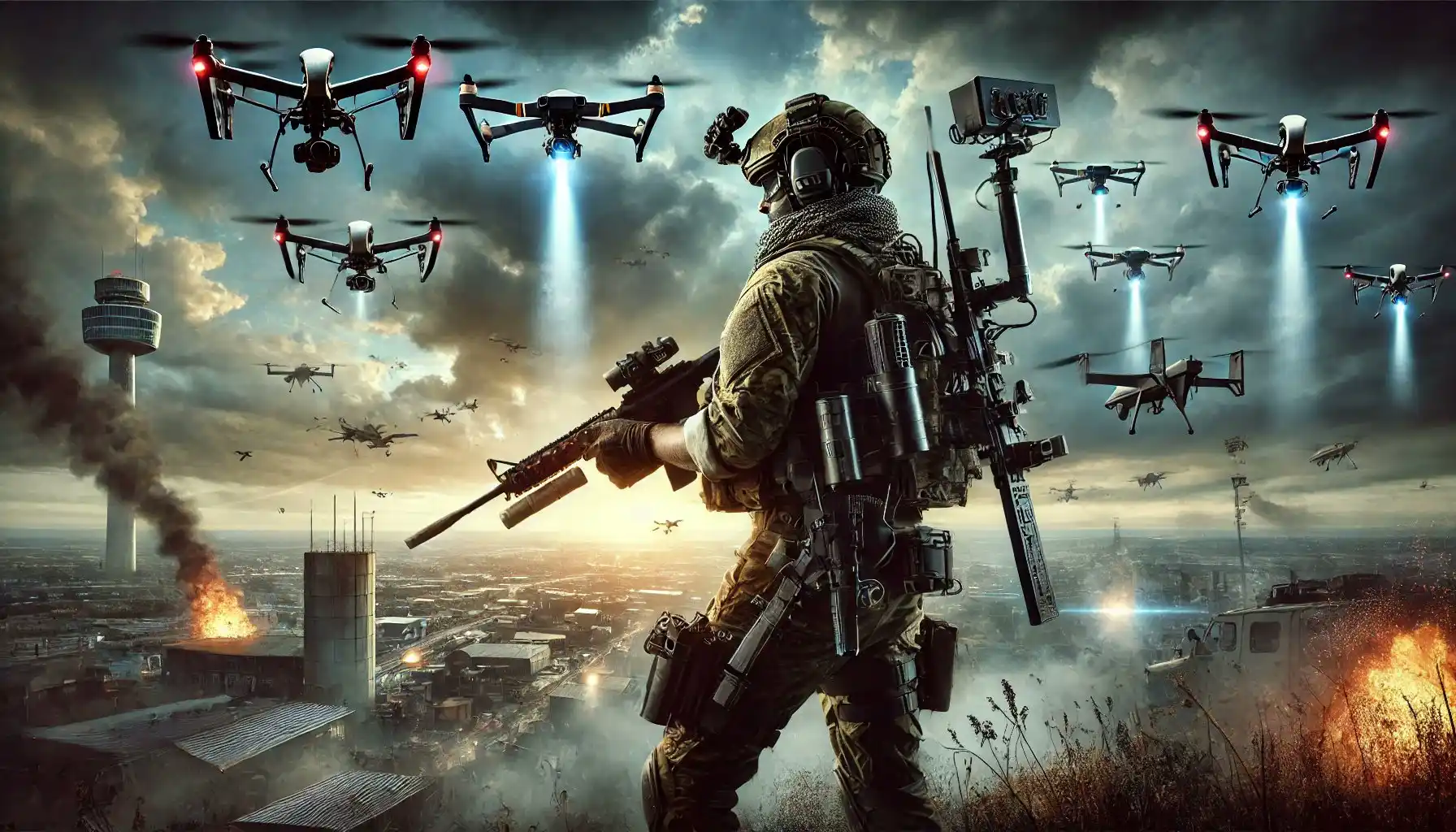
3.3.3. Tactical Versatility: The Role of Hybrid Loadouts
In dynamic battle scenarios, adaptability is critical. Pairing different weapons in your loadout ensures that you are prepared to face threats of varying sizes and capabilities. For example:
- Shotgun + Rifle: A shotgun for close-range defense and a .308 rifle for medium-range engagements create a versatile combination.
- Under-Barrel Attachments: Hybrid solutions allow seamless transitions, reducing downtime between engagements.
3.4. Conclusion
Mastering drone defense requires more than technical skill — it demands strategic insight and adaptability. The shotgun’s dominance in close-range scenarios, the .308 battle rifle’s balance of power and precision, and the .50 BMG’s ability to neutralize the toughest threats form the backbone of a comprehensive defense arsenal.
By understanding the strengths and limitations of these weapons and incorporating them into a cohesive strategy, defenders can confidently face the evolving challenges of the aerial battlefield. The skies may belong to the drones today, but with preparation and resolve, they can once again be reclaimed.
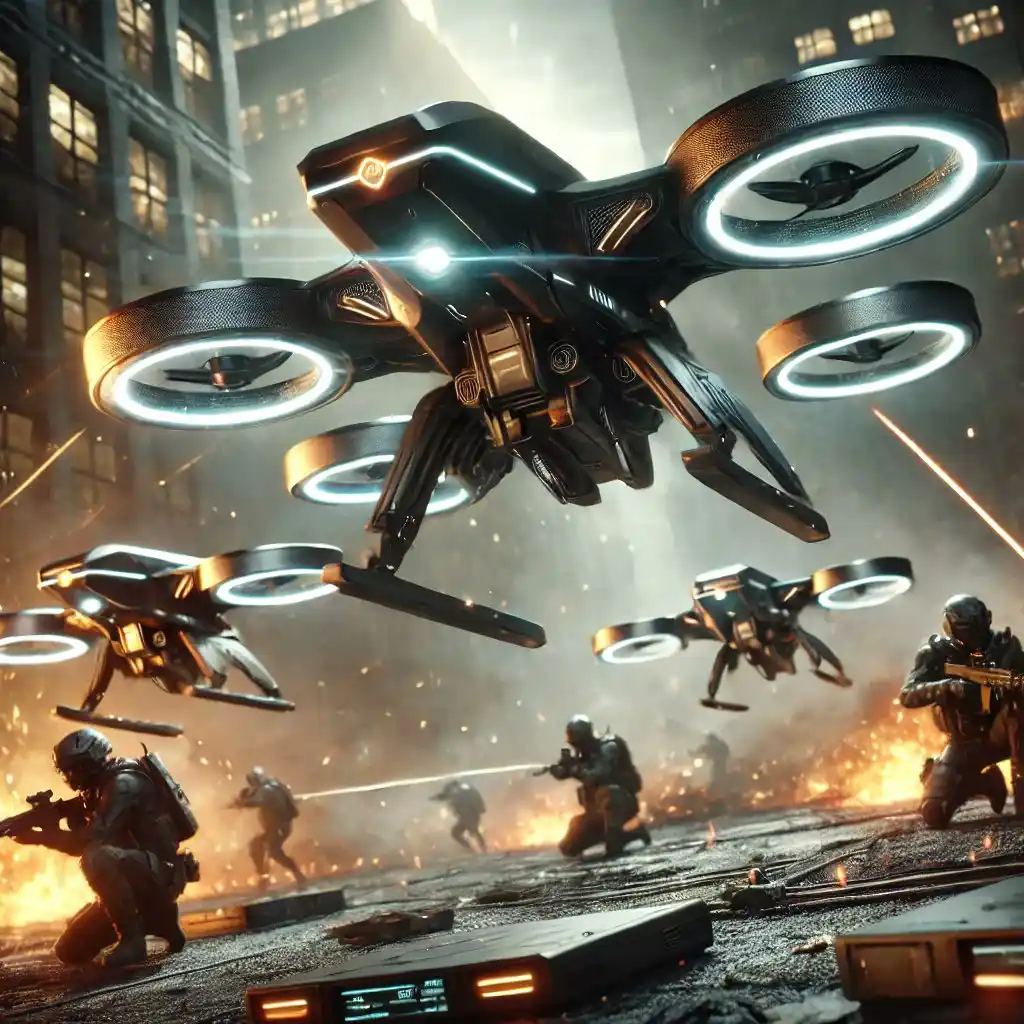
4. The Science of Stopping Power
In the battle against drones, precision isn’t just important — it’s essential. A single, well-placed shot can determine the difference between neutralizing a threat and leaving yourself vulnerable to retaliation. Stopping power, however, goes beyond the act of firing a bullet. It’s a science that demands an understanding of how ammunition interacts with drone materials, structures, and critical systems. Mastering this knowledge transforms defensive action from guesswork into calculated certainty.
This chapter delves into the mechanics of ballistics, the varieties of ammunition at your disposal, and how to tailor your loadout to neutralize specific drone threats effectively. With this foundation, defenders can engage with confidence and accuracy in the ever-evolving aerial battlefield.
4.1. Ballistics Analysis: Decoding the Drone’s Armour
Ballistics, the study of how projectiles behave, forms the cornerstone of drone defense. Each shot must consider the drone’s construction, speed, and the critical components that keep it operational. The interaction between the projectile and the drone’s materials is influenced by three essential factors:
1. Projectile Energy – Every bullet carries kinetic energy determined by its mass and velocity. Heavier, faster bullets deliver more energy upon impact, increasing the likelihood of disabling a drone. This energy is vital for breaching tough materials and delivering sufficient damage to critical systems.
2. Penetration Drones – range from lightweight plastic models to reinforced designs incorporating carbon fiber or light armour. A projectile must penetrate these materials to damage key components, such as rotors, sensors, or batteries.
3. Damage Spread –
Smaller drones often require wide-dispersal impact (e.g., birdshot) to ensure damage to their fragile frames. Larger, armored drones demand concentrated force on a single point, achievable with precision ammunition such as armor-piercing rounds.
Understanding these principles ensures that every shot counts, reducing wasted ammunition and maximizing effectiveness against diverse threats.
4.2. Ammunition Types: Tailoring Your Arsenal
The choice of ammunition directly impacts the success of an engagement. Each type is designed for specific tasks, and selecting the wrong one could mean the difference between success and failure. Below are the key ammunition types and their applications in drone defense:
4.3. Full Metal Jacket (FMJ): The All-Purpose Round
FMJ rounds are the workhorses of ammunition. Designed with a soft lead core encased in a harder metal jacket, they retain their shape during penetration, making them reliable for general-purpose defense.
Strengths:
- Consistent trajectory for accurate, long-range shots.
- Effective against lightweight materials like plastic or thin aluminum.
- Ideal for small to medium-sized drones with exposed components.
Weaknesses:
- Limited effectiveness against heavily armored drones.
- Can over-penetrate without causing catastrophic damage.
FMJ rounds are your go-to choice for unarmored UAVs and situations demanding consistent accuracy.
4.4. Armor-Piercing (AP): The Heavy Hitter
For drones with reinforced frames or light armor, AP rounds provide the necessary punch. Their dense cores, often made of steel or tungsten, focus kinetic energy on a small point, ensuring maximum penetration.
Strengths:
- Breaches materials like steel, Kevlar, or composite armor.
- Causes significant internal damage by targeting critical systems.
Weaknesses:
- Overkill for lightweight drones.
- Higher cost than FMJ rounds.
AP rounds are indispensable for large UAVs with protective casings, particularly when targeting propulsion systems or sensors.
4.5. Specialized Shotgun Shells: The Close-Combat Solution
Shotguns are unmatched in close-range engagements, and their effectiveness depends on the choice of shell:
- Birdshot: Best for small, fragile drones, birdshot disperses tiny pellets over a wide area. Effective within 25 meters, it maximizes hit probability against erratic targets.
- Buckshot: Suitable for medium-sized drones, buckshot fires fewer but larger pellets. Its range extends to 50 meters, with greater stopping power.
Shotgun shells are especially valuable in urban environments, where precision may be secondary to rapid engagement.
4.6. Velocity, Range, and Kinetics: The Science Behind the Shot
A bullet’s effectiveness diminishes with distance, a phenomenon known as kinetic decay. This interplay of velocity, range, and energy must be factored into every engagement:
- Close Range (<100 meters): At this range, most ammunition retains high velocity and stopping power. Shotguns and FMJ rounds are ideal for fast-moving threats.
- Mid-Range (100 – 300 meters): FMJ rounds maintain accuracy, while AP rounds excel against tougher drones. Precision optics become increasingly valuable.
- Long Range (300 – 600 meters): Precision is critical. High-caliber rifles equipped with advanced optics and AP ammunition dominate this engagement zone.
Defenders must position themselves strategically, ensuring they can target drones within their ammunition’s optimal range.
4.7. Preparing for Varied Threats: Building an Optimal Loadout
Defensive strategies require flexibility. No single ammunition type or weapon can address every drone threat. A well-prepared loadout includes tools for diverse scenarios:
1. Small Drones (e.g., quadcopters)
- Primary: Shotgun with birdshot or buckshot.
- Secondary: .308 rifle with FMJ rounds for extended range.
2. Medium Drones (e.g., surveillance UAVs)
- Primary: .308 rifle with a mix of FMJ and AP rounds.
- Secondary: Shotgun with buckshot for closer engagements.
3. Large Drones (e.g., armored UAVs)
- Primary: .50 BMG rifle or .308 rifle with AP rounds.
- Secondary: MANPADS or directed energy weapons for long-range threats.
Each loadout balances power, range, and flexibility, equipping defenders to handle a spectrum of threats.

4.8. Conclusion: Transforming Art into Science
The science of stopping power elevates drone defense into a calculated discipline. By understanding the nuances of ballistics, selecting the right ammunition, and tailoring loadouts for specific threats, defenders gain a critical edge. These strategies, grounded in precision and adaptability, allow defenders to face the skies with confidence.
As we move into the next chapter, we’ll explore the art of tactical transitions — seamlessly adapting strategies and tools in the heat of battle. Together, science and strategy form the foundation of reclaiming the skies.
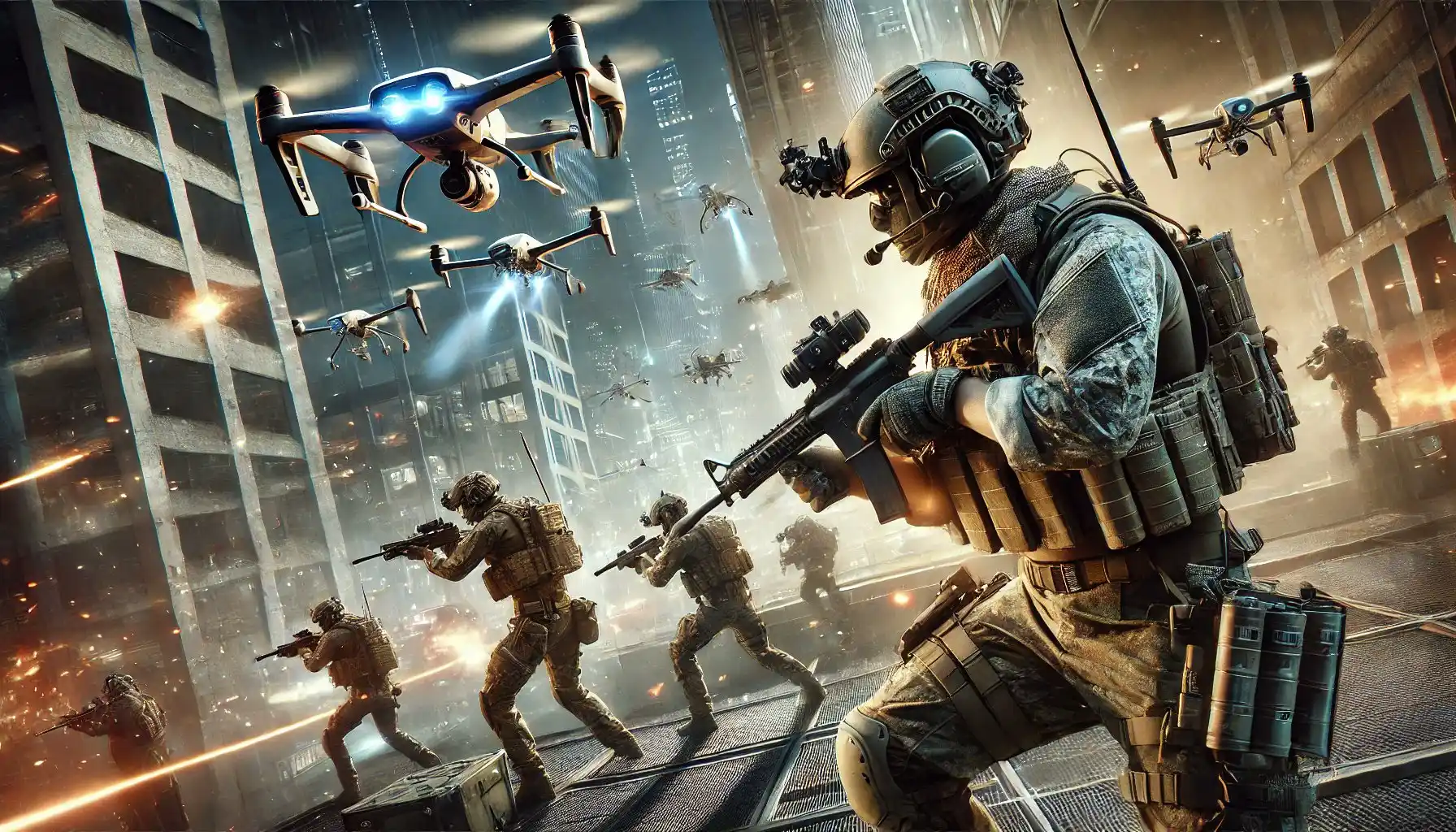
5. Tactical Transitions
The battlefield is a fluid and unpredictable arena, and the emergence of drones has amplified this complexity. These versatile machines challenge traditional combat tactics with their ability to maneuver unpredictably, launch attacks from unexpected angles, and deploy a wide range of payloads. To counter these threats effectively, defenders must excel at tactical transitions — the skill of seamlessly adapting weapons, strategies, and engagement techniques to confront evolving scenarios.
5.1. Adapting to Drone Types: Tailoring Responses to Threats
Drones vary widely in size, speed, and capability, and each type demands a unique approach. Whether facing a nimble quadcopter, a hovering surveillance drone, or a heavily armoured UAV, understanding these differences is the first step in crafting an effective defense.
5.2. Engaging Small Drones: The Speedsters
Small drones, such as quadcopters and FPV (first-person view) racing drones, are defined by their speed, agility, and erratic flight patterns. These qualities, combined with their ability to carry small payloads or disrupt electronics, make them challenging targets.
5.2.1. Weapons and Tactics
- Preferred Weapon: The shotgun is unmatched for close-range engagements. Its wide pellet spread compensates for the drone’s rapid and unpredictable movements. Birdshot is particularly effective, increasing the likelihood of rotor or structural damage.
5.2.2. Engagement Tactics
- Close the Gap: Small drones are most vulnerable within the shotgun’s effective range of 25–50 meters. Use natural cover or obstructions to approach undetected.
- Aim for Rotors: A single well-placed shot can destabilize the drone and send it crashing.
- Be Swift: Small drones rarely hover in one place for long. React quickly and decisively.
5.2.3. Transition Considerations
If the drone escapes shotgun range, transitioning to a battle rifle allows for extended engagement. However, avoiding detection and re-engaging at closer proximity is often more effective, as small drones typically have limited battery life.
5.3. Engaging Medium Drones: The Predators
Medium-sized drones, designed for surveillance or light attack roles, operate at greater distances and carry more sophisticated payloads. Their enhanced durability and loitering capabilities make them persistent threats.
5.3.1. Weapons and Tactics
- Preferred Weapon: The .308 battle rifle strikes a balance of precision and power, making it ideal for targeting critical systems such as sensors, rotors, or payload mounts.
5.3.2. Engagement Tactics
- Identify Weak Points: Focus fire on exposed components like cameras, rotors, or battery compartments.
- Controlled Fire: Semi-automatic fire provides accuracy while enabling quick follow-up shots.
- Employ Optics: Use a low-power variable optic (LPVO) to improve target acquisition at medium ranges (100 – 300 meters).
5.3.3. Transition Considerations
If a medium drone moves into close range, switch to a shotgun for rapid engagement. For targets retreating beyond the rifle’s range, reposition or employ long-range tools such as MANPADS (Man-Portable Air Defense Systems).
5.4. Engaging Large Drones: The Behemoths
Large drones, such as armed UAVs with light armour, are formidable adversaries. Slower and less agile, they compensate with heavy payloads and reinforced structures.
5.4.1. Weapons and Tactics
- Preferred Weapons: A .308 rifle with armor-piercing (AP) rounds or MANPADS is essential for penetrating their robust exteriors.
- Engagement Tactics:
1. Engage from Cover: Large drones often possess offensive capabilities. Use natural or constructed cover to minimize exposure.
2. Focus on Mobility: Target engines or rotors to immobilize the drone.
3. Precision Fire: Multiple well-placed shots are often necessary. Take time to align critical hits.
Transition Considerations : In the absence of long-range weapons like MANPADS or .50 BMG rifles, coordinated team efforts using jammers or hybrid tools become crucial.
5.5 Scenario Training: Developing Real-Time Adaptability
Combat is rarely static. Defenders must build muscle memory and decision-making skills to adapt effectively in dynamic environments.
5.5.1. Switching Weapons Efficiently
- Practice Transitions: Drill switching between a shotgun for close-range threats and a rifle for distant UAVs.
- Simulate Realistic Scenarios: Incorporate drone-like targets that shift between close and medium ranges, challenging shooters to adapt.
5.5.2. Prioritizing Threats
- In multi-drone scenarios, evaluate drones based on their capabilities and proximity. Small drones may distract from more significant threats.
- Swarms: Train to prioritize swarm scenarios by targeting key drones or deploying area-wide defenses like jammers.
5.5.3. Adapting to Battlefield Dynamics
- Incorporate terrain navigation into training to exploit natural and constructed cover.
- Conduct drills in varied environments, including urban, rural, and open fields, to prepare for diverse combat scenarios.
5.6. Hybrid Loadouts: Versatility for Every Scenario
A versatile loadout ensures rapid response to any drone threat, minimizing downtime between transitions.
- Example Loadout
- Primary: .308 battle rifle with LPVO for mid-range engagements.
- Secondary: Under-barrel shotgun attachment or standalone 12-gauge shotgun.
- Ammunition: FMJ and AP rounds for the rifle; birdshot for the shotgun.
- Support Tools: Anti-drone jammers or MANPADS for swarm or long-range threats.
- Key Benefits
- Flexibility: Adapt to close, mid, and long-range threats seamlessly.
- Efficiency: Reduce weight and complexity with integrated tools.
- Adaptability: Ensure continuous coverage, preventing defensive gaps.
5.7. Conclusion
Mastering tactical transitions transforms a defender’s response from reactive to proactive. By understanding the environment, leveraging the right tools, and honing adaptability, any engagement — be it a swarm of small drones, a single medium UAV, or a heavily armed behemoth — can shift in your favour. Tactical preparation ensures that the skies remain contested territory, reclaiming them from even the most advanced threats.
Part 3: Advanced Tools and Strategies
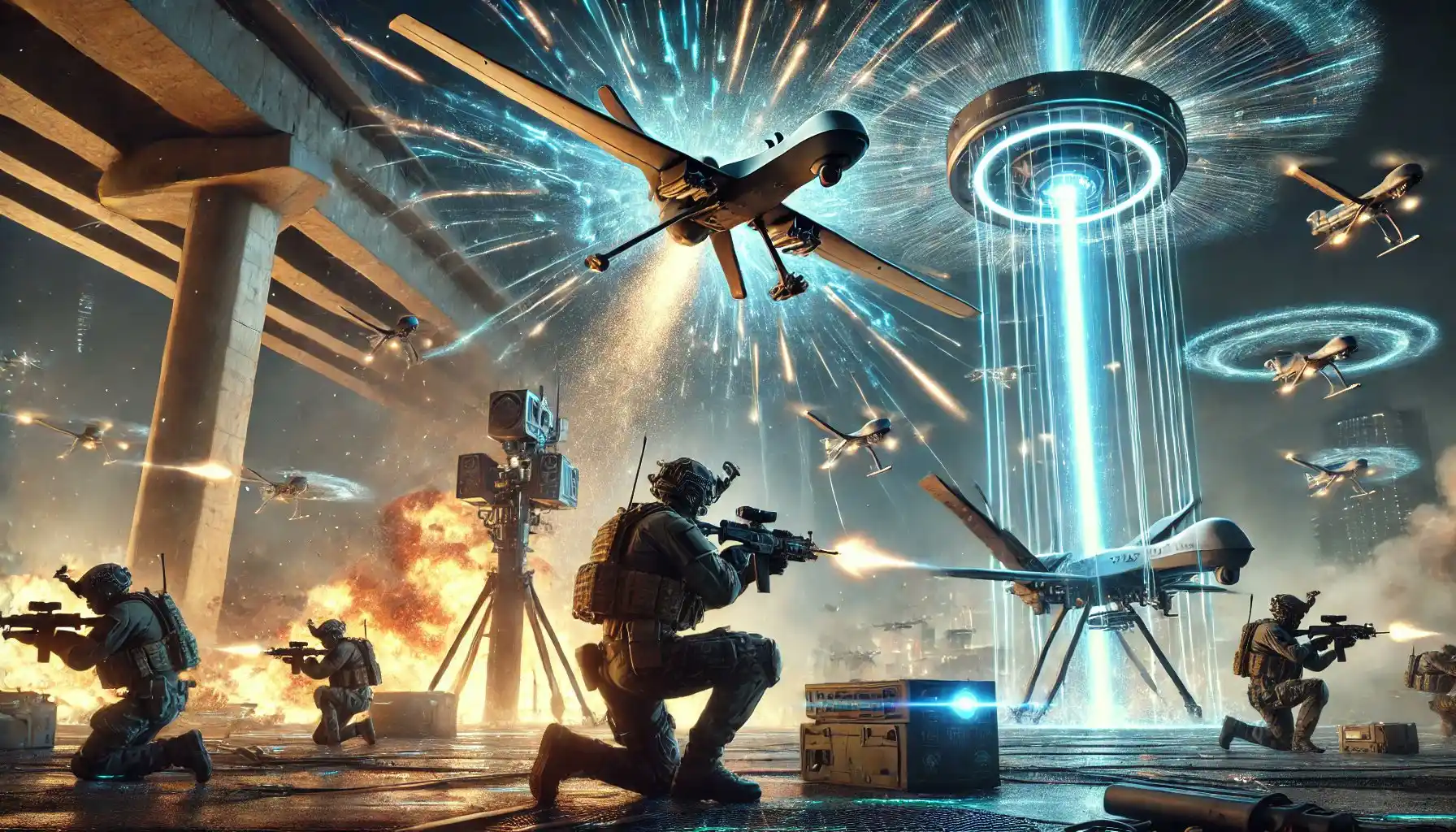
6. Advanced Tools of the Trade
As drones evolve, their threat becomes more sophisticated, challenging conventional defense measures. While traditional weapons like shotguns, rifles, and even heavy-caliber arms remain indispensable, they often fall short against the highly adaptive capabilities of modern unmanned aerial vehicles (UAVs). To address these challenges, a new arsenal of advanced tools has emerged, bringing cutting-edge technology to the forefront of drone defense. From jamming systems to directed energy weapons and autonomous counter-drones, the battle for the skies demands innovation, precision, and versatility.
6.1. Man-Portable Air Defense Systems (MANPADS): Precision at Range
Man-Portable Air Defense Systems, or MANPADS, have become a cornerstone in the fight against high-value UAVs. These shoulder-launched missile systems are specifically designed to neutralize aerial threats by leveraging advanced tracking and precision targeting. Originally deployed against manned aircraft, they are equally effective against large, heavily armed drones.
6.1.1. How MANPADS Work:
MANPADS rely on sophisticated heat-seeking or radar-guided technology to lock onto a drone’s heat signature or radar profile. Once fired, the missile pursues the target with exceptional precision, detonating upon impact or in close proximity.
6.1.1.1. Advantages
- Extended Range: Capable of engaging drones from several kilometers away, MANPADS enable operators to maintain a safe distance while neutralizing threats.
- Pinpoint Accuracy: Advanced guidance systems allow for precise targeting, even against fast-moving or evasive UAVs.
- Versatility: Effective across a wide spectrum of drone types, from reconnaissance UAVs to heavily armed systems.
6.1.1.2. Deployment Best Practices
- Strategic Positioning: Utilize elevated or concealed locations to maximize targeting range and minimize exposure.
- Coordinated Engagement: Pair MANPADS with early warning systems for optimal timing and accuracy.
- Resource Management: Given their cost and logistical demands, reserve MANPADS for high-priority or heavily fortified targets.
While MANPADS are a game-changing tool, their expense and operational complexity make them most suitable for military and high-security applications.
6.2. Anti-Drone Jammers: Disrupting Communication
Many drones rely on wireless communication with their operators for navigation, targeting, and control. Anti-drone jammers exploit this dependency, severing the link between drones and their operators. Without communication, drones may hover aimlessly, return to base, or crash — depending on their programming.
6.2.1. How Jammers Work
Anti-drone jammers emit electromagnetic interference across the frequencies commonly used by drones. By overwhelming the signal, these devices disrupt a drone’s ability to receive commands or transmit data.
6.2.1.1. Advantages
- Non-Destructive Solution: Jammers disable drones without causing physical damage, preserving them for potential intelligence analysis.
- Broad Coverage: Capable of neutralizing multiple drones within a specified range.
- Portable and Quick to Deploy: Compact designs allow for rapid deployment in dynamic situations.
6.2.1.2. Limitations
-
- Range Constraints: Most jammers operate within a radius of 500 meters to 2 kilometers, limiting their effectiveness in expansive areas.
- Autonomous Drones: UAVs programmed to operate without operator input are immune to jamming.
- Regulatory Restrictions: Some jurisdictions impose strict limitations on the use of jamming devices due to potential interference with civilian communication systems.
6.2.2. Ideal Applications
Anti-drone jammers excel in urban and sensitive environments where the risk of collateral damage from kinetic weapons is high. They are particularly effective at protecting infrastructure like airports, government buildings, and industrial facilities.
6.3. Directed Energy Weapons (DEWs): The Power of Precision
Directed Energy Weapons represent the pinnacle of drone defense technology. These systems use focused beams of energy, such as lasers or electromagnetic pulses, to disable drones with surgical precision.
6.3.1. Types of DEWs
1. Laser Weapons: High-energy lasers target key components, such as rotors or sensors, melting or overheating them.
2. Electromagnetic Pulse (EMP) Devices: EMPs emit powerful bursts of electromagnetic energy, disabling a drone’s electronics without direct contact.
6.3.1.1. Advantages
- Unlimited Engagements: As long as power is available, DEWs can neutralize multiple drones without requiring reloading.
- Silent Operation: These systems operate without detectable noise, reducing the risk of enemy detection.
- Precision: Ideal for targeting specific drones in a swarm without collateral damage.
6.3.1.2. Challenges
- Energy Demands: DEWs require significant power, limiting their portability.
- Environmental Sensitivity: Weather conditions such as fog, rain, or dust can reduce laser effectiveness.
- Cost: As an emerging technology, DEWs involve high development and deployment expenses.
6.3.2. Best Deployments
DEWs are most effective in static defense scenarios, such as military bases or naval vessels, where consistent power is available. Their precision makes them invaluable against swarms or high-value UAVs.
6.4. AI Counter-Drones: The Autonomous Defenders
As drones become smarter, so too must the systems that counter them. AI-driven counter-drones are emerging as a revolutionary tool, capable of identifying, tracking, and neutralizing UAVs without human input.
6.4.1. How They Work
AI counter-drones use advanced algorithms to scan airspace, differentiate between friend and foe, and engage hostile UAVs. Some employ kinetic methods, such as collisions, while others use electronic interference or nets.
6.4.1.1. Advantages
- Rapid Decision-Making: AI systems process data and execute actions faster than human operators.
- Multi-Target Engagement: Capable of neutralizing multiple drones simultaneously.
- Adaptive Learning: AI systems improve over time, adapting to new UAV tactics
6.4.1.2. Limitations
- Complexity: Requires advanced programming and robust hardware.
- High Initial Costs: Development and deployment involve significant investment.
- Data Dependency: Performance relies on comprehensive datasets for training.
6.4.2. Optimal
Use Cases AI counter-drones shine in fast-paced environments, such as battlefield scenarios or critical infrastructure defense, where rapid response is essential.
6.5. Emerging Solutions: Nets and Cyber Warfare
6.5.1. Innovation in Drone Defense
Innovation in drone defense continues with the development of unconventional yet effective tools: deployable nets and cyber warfare techniques.
- Nets: Launched from handheld devices or UAVs, nets entangle drones mid-flight. They are particularly effective for capturing small or medium-sized UAVs intact.
- Cyber Warfare: By exploiting software vulnerabilities, cyber tools can hijack drones, disable them remotely, or extract critical data for intelligence.
6.5.1.1. Advantages
- Low Collateral Damage: Both nets and cyber tools neutralize drones without physical destruction.
- Precision: Effective for high-priority targets.
- Adaptability: Easily integrated into existing defense systems.
6.5.1.2. Applications
Nets are best suited for urban environments where physical engagement risks collateral damage, while cyber tools excel in intelligence-driven missions.
6.6. Conclusion
The evolving drone threat has demanded an arsenal as dynamic and innovative as the adversary itself. From MANPADS and jammers to lasers, AI counter-drones, and emerging solutions, these tools represent the forefront of modern drone defense. Yet no single system is sufficient for every scenario. Success lies in creating a cohesive, layered defense strategy that leverages the strengths of each technology. By mastering these advanced tools, defenders can reclaim the skies and safeguard the future.
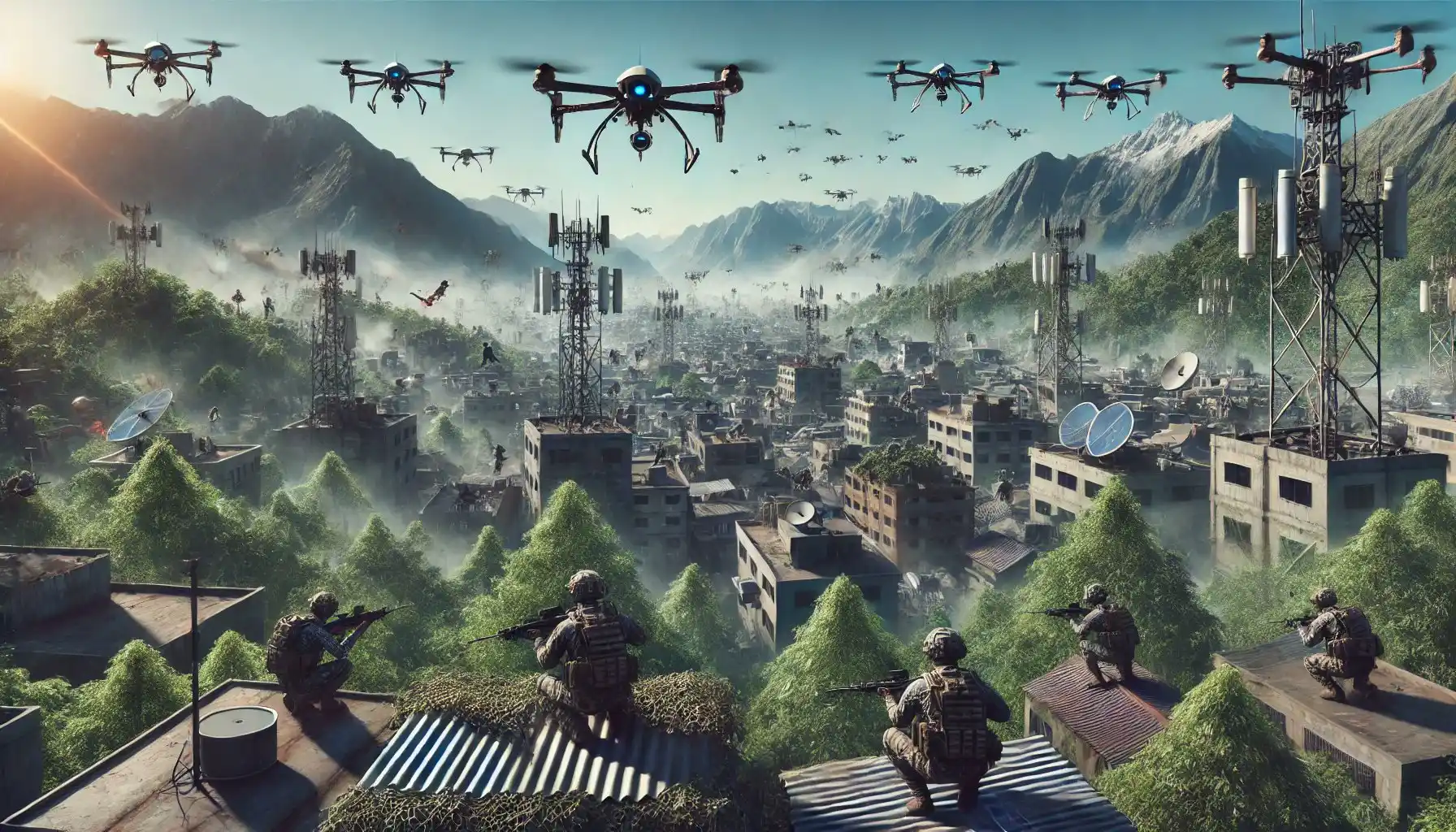
7. Tactical Insights from the Field
The battle against drones has evolved as rapidly as the technology itself. Across war-torn battlefields and densely populated urban areas, defenders face unprecedented challenges. The ingenuity and adaptability shown by those combating drones have given rise to new strategies, many shaped by the specific environments in which they are deployed. This chapter delves into key lessons from conflict zones, strategies tailored for urban settings, and the innovative use of terrain to tip the balance in drone engagements.
7.1. Lessons from Conflict Zones
Modern warfare has brought drones into sharp focus, particularly in conflicts such as those in Ukraine and Syria. These theaters of war reveal how drones have transformed into tools of precision and terror—and how defenders have adapted.
7.2. Ukraine: Survival Against Precision
The conflict in Ukraine underscores the dual-edged nature of drones. Both sides utilized unmanned aerial vehicles (UAVs) for reconnaissance, artillery targeting, and precision strikes. The Ukrainian forces faced an evolving challenge, prompting creative countermeasures.
- Improvised Defenses: Ukrainian civilians and soldiers made effective use of readily available technologies. Radio enthusiasts employed spectrum analyzers to detect drone frequencies, aiding jamming efforts. Makeshift tools, such as net launchers and shotgun shells loaded with improvised pellets, became critical in close-range drone engagements.
- Camouflage and Deception: The use of decoys such as fake artillery pieces misled drone operators, drawing fire away from real targets. Troops also employed thermal countermeasures — setting fires or using heaters to confuse drones equipped with infrared sensors.
- Swarm Defense: In response to swarms, soldiers coordinated saturation fire from rifles and machine guns. These tactics relied heavily on disciplined communication and training to neutralize multiple UAVs in rapid succession.
7.3 Syria: Guerrilla Innovation
In Syria, non-state actors demonstrated the power of off-the-shelf drones modified for warfare. Defenders responded with strategies rooted in simplicity and adaptability.
- Small Arms Accuracy: Urban defenders prioritized training with small arms, improving their ability to quickly target drones. Mounted machine guns became pivotal for engaging medium-altitude UAVs.
- Environmental Exploitation: Smoke grenades and burning tires obscured the battlefield, reducing the effectiveness of drones relying on visual or thermal imaging. Layered overhead nets created drone-free zones over critical areas.
- Low-Tech Jamming: Crude but effective jammers, built from scavenged electronics, established localized drone “dead zones.” While unsophisticated, these devices proved vital in disrupting UAV operations.
7.4 Urban Defense: Unique Challenges and Strategies
Urban areas present a distinct set of challenges in drone defense. High-rise buildings, narrow streets, and dense populations amplify the risks while constraining visibility and engagement options. Yet, these complexities also open doors for innovation.
7.4.1. Challenges of Urban Drone Defense
1. Restricted Line of Sight:
Buildings and narrow alleys block views, complicating early detection and precise targeting.
2. Collateral Damage Risks:
Firearms or explosives used in populated areas may harm civilians or infrastructure.
3. Operator Ambiguity:
Identifying drone operators among civilians adds an additional layer of complexity.
7.4.2. Strategies for Urban Defense
1. Building-Based Defenses:
Observers and shooters stationed on rooftops expand visibility and engagement options. Deploying net launchers or portable jammers from elevated positions helps intercept low-flying drones.
2. Overhead Protection:
Installing tensioned nets over critical zones, such as markets or government buildings, creates barriers that prevent drone penetration. Camouflaging rooftops with reflective or heat-blocking materials can also obscure them from reconnaissance drones.
3. Mobile Response Teams:
Lightweight jammers and shotguns make urban patrol units agile and effective. Quick-response drills ensure that sightings of drones lead to swift action, minimizing threats.
4. Digital Countermeasures:
Anti-drone software integrated into public and private surveillance systems turns existing infrastructure into detection tools. Signal triangulation can locate operators for ground forces to neutralize.
7.5. Terrain Exploitation: Using Nature to Your Advantage
The natural environment often dictates the tactics used in drone defense. Open fields, forests, mountains, and deserts each present unique advantages and obstacles.
7.5.1. Forested and Vegetative Terrain
Thick vegetation obscures drones from sight but also muffles their noise, making detection challenging.
- Countermeasures: Use tree canopies for concealment, hindering drones’ ability to visually or thermally detect targets. Stretch camouflaged nets between trees to intercept low-flying UAVs.
7.5.2. Mountainous Regions
High altitudes reduce UAV performance, but the terrain can also restrict movement.
- Countermeasures: Position anti-drone jammers or rifles on peaks to maximize detection and engagement ranges. Use natural rock formations for protection against aerial surveillance and strikes.
7.5.3. Deserts and Open Plains
Wide visibility in open areas leaves defenders exposed but also aids in spotting drones early.
- Countermeasures: Leverage long-range optics and thermal imaging to identify drones at maximum distances. Establish mobile defenses using vehicles outfitted with mounted jammers or rifles.
7.6 Conclusion
Conflict zones, urban environments, and diverse terrains each demand unique approaches to drone defense. The lessons learned from Ukraine and Syria, coupled with adaptive strategies for urban and natural landscapes, demonstrate that defenders can outmaneuver even the most advanced UAV threats. By studying these scenarios and incorporating their insights, defenders can develop robust systems to reclaim control of the skies.
In the next chapter, we will explore case studies in drone defense, delving into real-world applications that reveal the successes, failures, and innovations shaping this evolving battlefield. The experiences of today will become the strategies of tomorrow, laying the groundwork for a more secure future.
Part 4: Mastery and Future Readiness
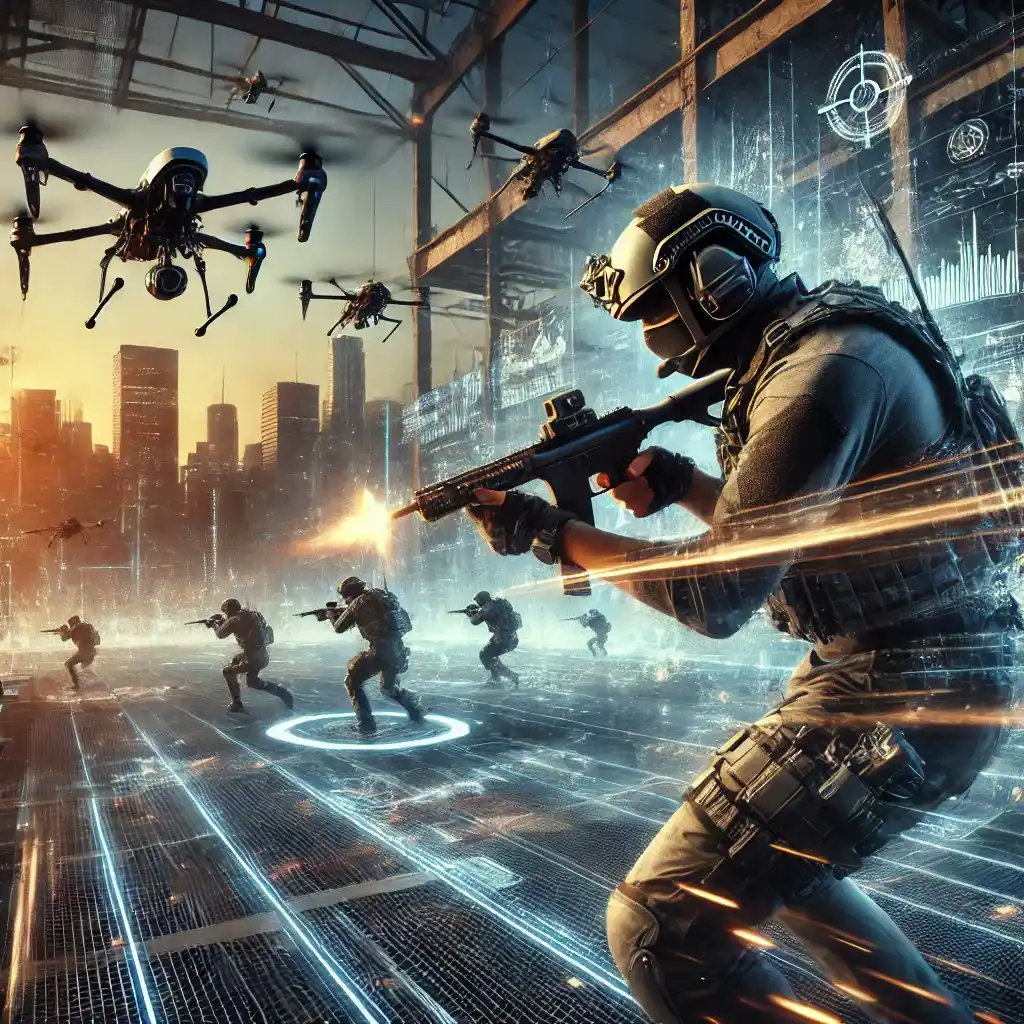
8. The Path to Mastery
Mastering drone defense is not simply about acquiring tools or identifying threats; it requires developing a skillset rooted in precision, adaptability, and mental fortitude. In the rapidly evolving landscape of aerial threats, mastery is a continuous journey — one that demands practice, analysis, and resilience. Whether protecting vital infrastructure, engaging in battlefield operations, or ensuring civilian safety, the path to mastery is built on a foundation of knowledge and preparation.
8.1. Foundations of Training
Effective drone defense begins with rigorous training. This involves cultivating dynamic marksmanship, perfecting weapon transitions, and immersing oneself in realistic simulation drills to prepare for the unpredictable nature of aerial threats.
8.2. Dynamic Marksmanship for Aerial Targets
Drone engagements differ from traditional targets due to their agility, speed, and erratic flight patterns. Success requires precision shooting paired with anticipation and adaptability.
- Tracking and Leading: To hit a moving target, shooters must aim ahead of its trajectory. This compensates for the time it takes the projectile to reach the drone, ensuring accuracy even at high speeds.
- Controlled Breathing: Physical tension can compromise aim. Techniques like steady, rhythmic breathing improve focus and enhance accuracy, particularly when targeting drones at varying altitudes or speeds.
- Practice with Realism: Simulate combat conditions by using drone-like aerial targets in live-fire drills. These targets should mimic evasion tactics, challenging shooters to adapt quickly and refine their skills.
8.3. Quick Transitions Between Weapons
Drone threats can range from small, low-altitude UAVs to larger, heavily armoured drones. Fluidly transitioning between different weapons — such as a shotgun for close-range encounters and a rifle for distant threats — is crucial for maintaining operational dominance.
- Loadout Familiarity: Position weapons for easy access and rehearse transitions under simulated stress conditions to build muscle memory and reduce hesitation during engagements.
- Transition Drills: Structured exercises should involve engaging small drones with a shotgun before switching to a rifle for medium-range targets. This reinforces the ability to adapt seamlessly to shifting scenarios.
- Efficient Reloading: Mastering quick reloads ensures continuous firepower when faced with a persistent or advancing threat.
8.4. Simulation Drills Mimicking Real-World Scenarios
Controlled training environments only partially prepare defenders for the unpredictability of real-world drone engagements. Simulation drills replicate combat conditions, bridging the gap between theory and practice.
- Urban Defense Scenarios: Set up mock environments featuring narrow alleys, rooftops, and densely packed buildings. These drills help defenders navigate complex urban terrain while maintaining readiness.
- Open Terrain Engagements: Practice long-range detection and targeting in expansive fields or deserts, using optics to identify weak points and track drones in clear, unobstructed spaces.
- Swarm Simulation: Prepare for scenarios involving multiple drones approaching simultaneously. Focus on prioritizing threats, communicating effectively with team members, and adapting to overwhelming situations.
8.5. Mental Preparedness: Building the Warrior Mindset
Drone engagements test not only physical skill but also mental resilience. Staying calm and focused in the face of fast-moving threats is as vital as accurate shooting.
8.5.1. Managing Stress
The constant hum of drones overhead can instill anxiety, even in experienced defenders. Mental clarity under pressure is achieved through intentional techniques.
- Controlled Breathing and Focus: Methods like box breathing — inhale for four counts, hold for four counts, exhale for four counts — calm the nervous system and restore composure during high-stress encounters.
- Visualization Exercises: Before a scenario, mentally rehearse success. Visualize tracking, aiming, and disabling the drone. This mental preparation builds confidence and reduces hesitation.
8.5.2. Adaptability Under Pressure
- Drones are inherently unpredictable, and engagements often shift rapidly. Adapting to these changes in real time is critical.
- Scenario-Based Problem Solving: Incorporate training exercises where unexpected variables emerge, such as drones deploying decoys or operators switching tactics. These challenges hone problem-solving and flexibility.
8.6. Learning and Adapting: The Continuous Journey
Each engagement offers valuable lessons, whether the outcome is a success or a failure. Mastery requires the discipline to reflect on experiences and refine strategies continually.
8.6.1. Debriefing and Analysis
After every exercise or real-world engagement, thorough reviews are essential to identify strengths and weaknesses.
- Successes: Analyze what worked well and why. Understanding these factors allows for the replication of effective strategies.
- Failures: Examine gaps in execution or planning. Use these insights to make targeted improvements.
- Adjustments: Incorporate lessons learned into subsequent training sessions to ensure continuous growth.
8.6.2. Staying Updated
The rapid evolution of drone technology demands vigilance and a commitment to staying informed.
- Industry Developments: Monitor advancements in UAV capabilities and countermeasures.
- Knowledge Sharing: Engage with professional communities to exchange insights and learn from others’ experiences.
- Testing New Solutions: Regularly evaluate and integrate emerging tools or tactics to remain ahead of the curve.
8.7. Conclusion
The path to mastery in drone defense is a dynamic and unending journey. It requires a blend of technical skill, mental resilience, and an unyielding commitment to learning. By refining physical abilities, fostering a warrior mindset, and embracing the lessons of every engagement, defenders can rise to meet the challenges of modern aerial threats.
As drones continue to reshape the nature of conflict, those who pursue mastery will stand as the vanguard, reclaiming control of the skies with precision, confidence, and determination. The journey is challenging, but for those who embrace it, mastery offers the ultimate reward: the ability to safeguard lives and secure the future.
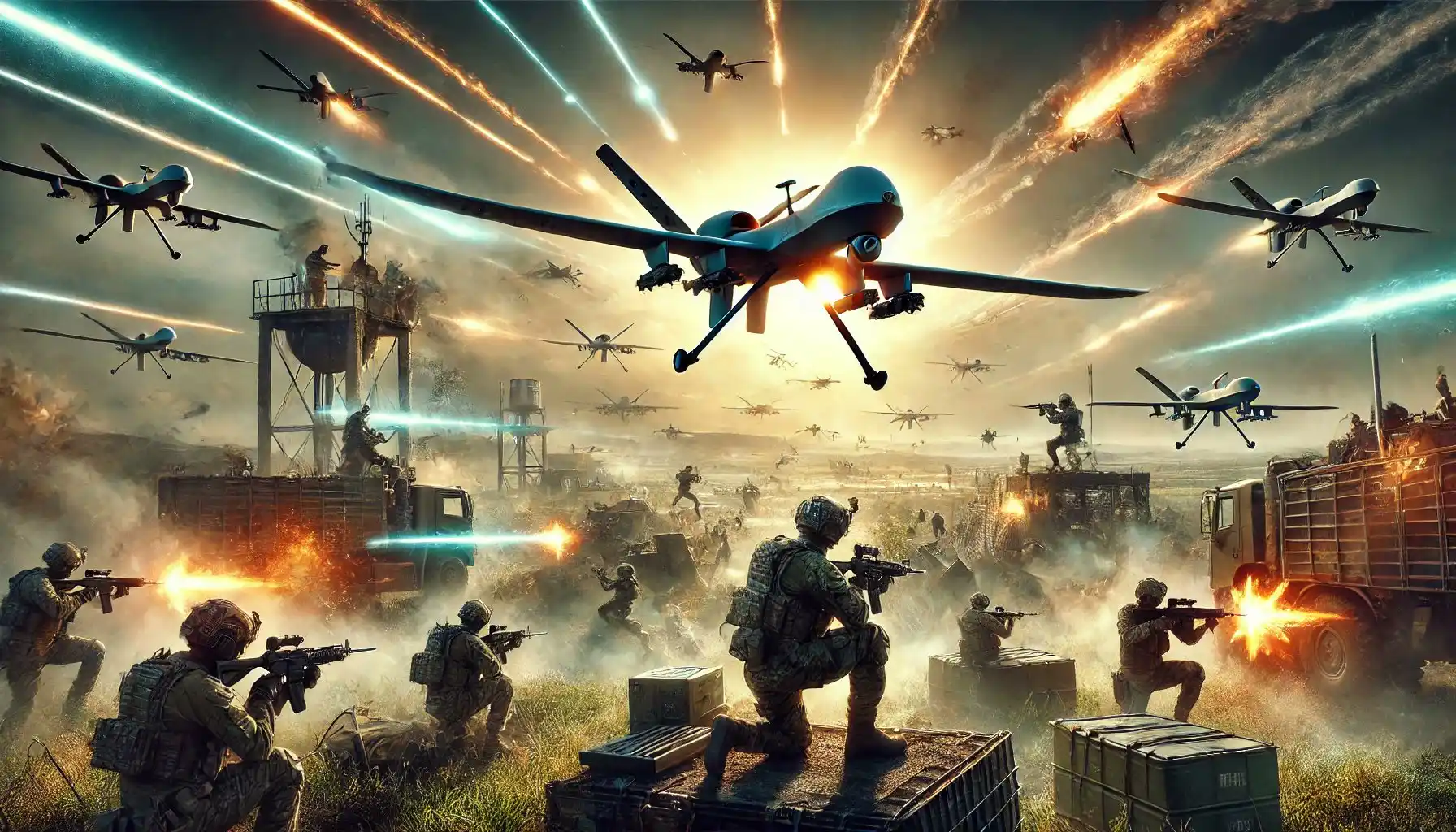
9. Case Studies in Drone Defense
The evolution of drone warfare over the past decade has demonstrated the immense potential and peril of unmanned aerial systems (UAS). From high-tech military operations to grassroots civilian solutions, each encounter offers critical insights into how drones are employed and how they can be countered. This chapter explores key case studies, including the Nagorno-Karabakh conflict, innovative civilian approaches, and the advancements in military countermeasures, to illustrate the creative resilience required to address this rapidly advancing threat.
9.1. The Nagorno-Karabakh Conflict: A Battlefield Revolution
In the autumn of 2020, the mountainous region of Nagorno-Karabakh became the proving ground for one of the most drone-intensive conflicts in history. The war between Azerbaijan and Armenia underscored the transformative power of drones, forever altering the dynamics of modern warfare.
9.1.1. Dominance in the Skies
Azerbaijan’s strategic deployment of drones, sourced from Turkey and Israel, provided a decisive edge. The Turkish Bayraktar TB2 drones and Israeli Harop loitering munitions (nicknamed “kamikaze drones”) executed precision strikes that systematically dismantled Armenian defenses.
9.1.2. Tactics of Destruction
- The Bayraktar TB2 drones acted as both scouts and assassins, leveraging real-time reconnaissance to identify and target artillery positions, armored vehicles, and troops with surgical precision.
- Loitering munitions like the Harop hovered over the battlefield, waiting for the ideal moment to dive into their targets, creating both physical devastation and psychological dread.
- The Human Toll The relentless presence of drones not only crippled Armenia’s defenses but also demoralized its troops. Soldiers who lacked adequate counter-drone capabilities often felt exposed and powerless under the watchful eyes of the UAVs.
9.1.4. Emerging Defenses and Lessons Learned
Despite Azerbaijan’s dominance, the Armenian forces improvised countermeasures that, while limited, provided valuable insights into counter-drone tactics:
- Camouflage and Decoys: Troops used thermal covers, natural foliage, and dummy equipment to confuse enemy drones, diverting strikes from critical assets.
- Electronic Countermeasures: Jamming equipment disrupted drone communications, though the success rate was inconsistent against advanced systems.
- Fortified Positions: Underground bunkers and reinforced shelters offered temporary reprieves, though their immobility limited tactical flexibility.
9.1.4. Takeaway for Future Conflicts
The Nagorno-Karabakh war demonstrated the need for layered defenses that integrate electronic, physical, and operational measures. It highlighted the vulnerabilities of traditional military setups when faced with cutting-edge drone technology.
9.2. Civilian Innovations: Creativity Meets Necessity
Outside the realm of formal militaries, civilians and small organizations have devised ingenious solutions to counter drones. These grassroots approaches showcase the resilience and resourcefulness of communities grappling with UAS threats.
9.2.1. Urban Innovations
In urban areas, where drones pose risks ranging from privacy violations to acts of terrorism, civilians and local authorities have adopted unconventional methods:
- Net Launchers: Police forces and private security teams have employed devices that shoot entangling nets to incapacitate drones mid-air. These tools are precise and non-lethal, making them ideal for crowded environments.
- Falconry Reimagined: European cities have trained birds of prey, such as eagles, to intercept and disable drones. This ancient hunting technique has found new relevance in the modern age.
- Hobbyist Solutions: Tech-savvy civilians have repurposed off-the-shelf electronics to build jamming devices or interceptors, demonstrating the accessibility of counter-drone innovation.
9.2.2. Rural Resilience
In rural settings, drones often disrupt agriculture or conduct unauthorized surveillance. Farmers and landowners have turned to pragmatic defenses:
- Firearms: Shotguns and rifles remain go-to tools for low-altitude drone threats. Proper training ensures safe and effective engagements.
- Laser Pointers: High-powered lasers can temporarily blind drone sensors, though they require careful use to avoid unintended consequences.
- Natural Camouflage: Farmers use tree cover and strategic crop patterns to shield fields from aerial observation, blending technology with tradition.
9.2.3. Takeaway for Communities
These civilian-led strategies highlight the power of adaptability and creativity. By leveraging available resources and local knowledge, communities can effectively mitigate drone risks without access to high-tech equipment.
9.3. Military Advances: The Cutting Edge of Counter-Drone Technology
As drones have become integral to modern combat, militaries worldwide have prioritized the development of advanced countermeasures. These efforts represent a sophisticated response to increasingly complex UAS threats.
9.3.1. Integrated Defense Systems
Modern militaries rely on layered systems that combine detection, disruption, and destruction to neutralize drones at various ranges:
- Short-Range Defenses: Directed energy weapons (lasers) and shotgun-mounted systems provide quick, precise responses to low-flying drones.
- Medium-Range Solutions: Systems like the Pantsir-S1 use radar-guided munitions and electronic jamming to counter UAVs operating at altitudes of hundreds of meters.
- Long-Range Engagements: High-value drones are engaged with surface-to-air missiles (SAMs) or man-portable air defense systems (MANPADS).
9.3.1. AI Integration: The Future of Defense
Artificial intelligence is revolutionizing counter-drone strategies, enabling militaries to process threats faster and more accurately:
- Autonomous Tracking: AI-driven systems analyze drone movements, prioritize targets, and recommend optimal responses in real time.
- Swarm Neutralization: AI-powered drones can counter enemy UAV swarms with coordinated, multi-target engagements.
9.4.1. Collaborative Advancements
International cooperation has accelerated progress in counter-drone technologies:
- NATO Initiatives: Member states share research, training, and deployment strategies, ensuring interoperability across allied forces.
- Private Sector Contributions: Companies specializing in AI, robotics, and aerospace provide cutting-edge solutions that enhance military capabilities.
9.4.2. Takeaway for Armed Forces
Military advancements demonstrate the importance of collaboration and innovation. By integrating technology, training, and partnerships, nations can effectively defend against even the most advanced drone threats.
9.5. Conclusion: Lessons for the Future
The Nagorno-Karabakh conflict, grassroots civilian solutions, and military innovations all underscore the evolving nature of drone defense. Each case study reveals unique challenges and opportunities, from the battlefield to urban and rural settings. Together, they illustrate the adaptability and ingenuity required to reclaim control of the skies.
As we look to the future, these lessons must inform our strategies and inspire further innovation. In the face of increasingly complex UAS threats, resilience and creativity will remain humanity’s greatest assets. The battle for the skies is ongoing, but with the right tools and tactics, it is one we are equipped to win.

10. Ethical and Policy Considerations
In the rapidly evolving battle to reclaim the skies, technology and tactics are crucial, but they are not the whole story. Equally important are the ethical and legal frameworks that govern counter-drone operations. Striking a delicate balance between ensuring security and upholding civil liberties is paramount. Counter-drone strategies must safeguard privacy, respect international norms, and foster global cooperation to ensure that the tools of defense do not inadvertently erode the very freedoms they aim to protect.
This chapter delves into these complex considerations, presenting a roadmap to guide ethical counter-drone policies and practices.
10.1. Balancing Defense with Privacy: The Surveillance Dilemma
Imagine a world where every drone in the sky, friendly or hostile, is met with a barrage of monitoring technologies — radar systems that capture its trajectory, thermal imaging that identifies its heat signature, and cameras that document its every move. While these tools are vital for identifying threats, they come with an unintended consequence: the potential infringement on privacy.
Counter-drone technologies often blur the lines between necessary surveillance and overreach. Radar systems might inadvertently monitor civilian air traffic; optical sensors might capture private activities. Without proper oversight, these systems risk turning the skies into a theater of unwarranted surveillance.
10.1.1. The Trust Factor
Excessive or indiscriminate use of surveillance erodes public trust. When individuals suspect their movements are being monitored under the guise of drone defense, it fosters an atmosphere of suspicion and resistance — undermining the legitimacy of even the most well-intentioned initiatives.
10.1.2. Guiding Principles for Privacy Protection
To navigate these challenges responsibly, counter-drone operations must adhere to principles that prioritize privacy without compromising security:
- Proportionality: Deploy surveillance tools only in response to specific, credible threats. Avoid blanket monitoring in areas where no significant risks exist.
- Transparency: Inform the public about the purpose, scope, and limits of counter-drone operations. Transparency fosters trust and accountability.
- Data Minimization: Design systems to collect only the data necessary for threat identification, with strict safeguards against misuse.
- Regular Audits: Conduct independent reviews to ensure compliance with privacy standards and address lapses promptly.
By embedding these principles into policy and practice, drone defense can coexist with respect for individual rights.
10.2. Regulating Countermeasures: Crafting a Legal Framework
Counter-drone technologies — jammers, directed energy weapons (DEWs), and AI-driven systems — present not only technical challenges but also legal and ethical dilemmas. These tools, if misused or poorly regulated, could disrupt civilian life or escalate conflicts. The task of creating fair, enforceable regulations is as essential as deploying the technologies themselves.
10.2.1. The Complexity of Regulation
Consider the dual-use nature of many counter-drone tools. Jammers, for instance, can neutralize rogue UAVs but may also interfere with civilian communications. Directed energy weapons offer precision but carry the risk of collateral damage in populated areas. And AI systems raise questions of accountability: if an autonomous drone defense system malfunctions, who bears responsibility?
10.2.2. Building Robust Legal Frameworks
To address these complexities, nations must adopt comprehensive frameworks that balance security needs with ethical considerations:
- Licensing and Authorization: Require all operators of counter-drone systems to obtain licenses, ensuring adherence to strict usage guidelines.
- Rules of Engagement: Define clear protocols for deploying countermeasures, ensuring their use is proportional to the threat and avoids unnecessary harm.
- Civilian Safeguards: Restrict high-risk tools like DEWs in urban environments, where they could endanger civilian lives.
- AI Accountability: Mandate human oversight for autonomous systems and establish liability mechanisms for errors or unintended harm.
10.2.3. Global Collaboration on Regulations
Given the interconnected nature of airspace and drone activity, no single nation can tackle these challenges in isolation. International cooperation is crucial:
- Standardizing Regulations: Develop universal standards for the ethical use of counter-drone tools.
- Sharing Best Practices: Encourage dialogue among nations to share experiences and innovations.
- Enforcing Compliance: Establish mechanisms to monitor adherence to international agreements and address violations.
Through collaborative efforts, the global community can create a unified front against drone-related threats.
10.2.4. Global Collaboration: Strength in Unity
The challenges posed by drones transcend national borders. From criminal networks using drones for smuggling to terrorist groups employing UAVs as weapons, these threats demand a coordinated, international response.
10.2.5. The Role of Partnerships
Global partnerships are essential for building an effective and sustainable defense:
- Joint Research Initiatives: Nations can pool resources to develop cutting-edge counter-drone technologies. Partnerships with academia and private industry accelerate innovation.
- Capacity Building: Provide technical support and training to nations with limited resources, ensuring a uniform global standard of defense.
- Intelligence Sharing: Establish secure channels to share data on emerging threats, tactics, and vulnerabilities.
10.2.6. Addressing Asymmetric Threats
Non-state actors often exploit the accessibility and affordability of drones to disrupt civilian and military systems. Combating these asymmetric threats requires creative and unified approaches:
- Disrupting Supply Chains: Coordinate efforts to restrict access to drones and components that can be weaponized.
- Maintaining Watchlists: Create and share databases of operators and organizations known for illicit drone activities.
- Unified Protocols: Establish joint response strategies for cross-border drone incursions.
By combining resources, knowledge, and strategy, the international community can present a formidable defense against shared threats.
10.2.7. Promoting Responsible Use
While building defenses, it is equally important to ensure that counter-drone systems are not themselves a source of abuse. Non-proliferation agreements, respect for sovereignty, and a commitment to human rights must underpin every counter-drone initiative.
- Non-Proliferation Agreements: Limit the export of advanced counter-drone technologies to regimes or groups likely to misuse them.
- Respect for Sovereignty: Avoid unilateral actions that infringe on another nation’s airspace or provoke unnecessary escalation.
- Ethical Standards: Commit to transparency, accountability, and restraint in the use of counter-drone tools.
10.3. Conclusion: A Balancing Act
The ethical and policy dimensions of drone defense are as critical as the technological ones. A robust framework that prioritizes privacy, establishes clear regulations, and fosters global cooperation can ensure that counter-drone initiatives serve the greater good.
The skies are a contested domain, but through wisdom, restraint, and collaboration, we can reclaim them — not just for safety, but for the values that define us. In the end, the battle for the skies is not only about neutralizing threats but about safeguarding the freedoms and principles that make those skies worth defending.
Part 5: Preparing for the Future
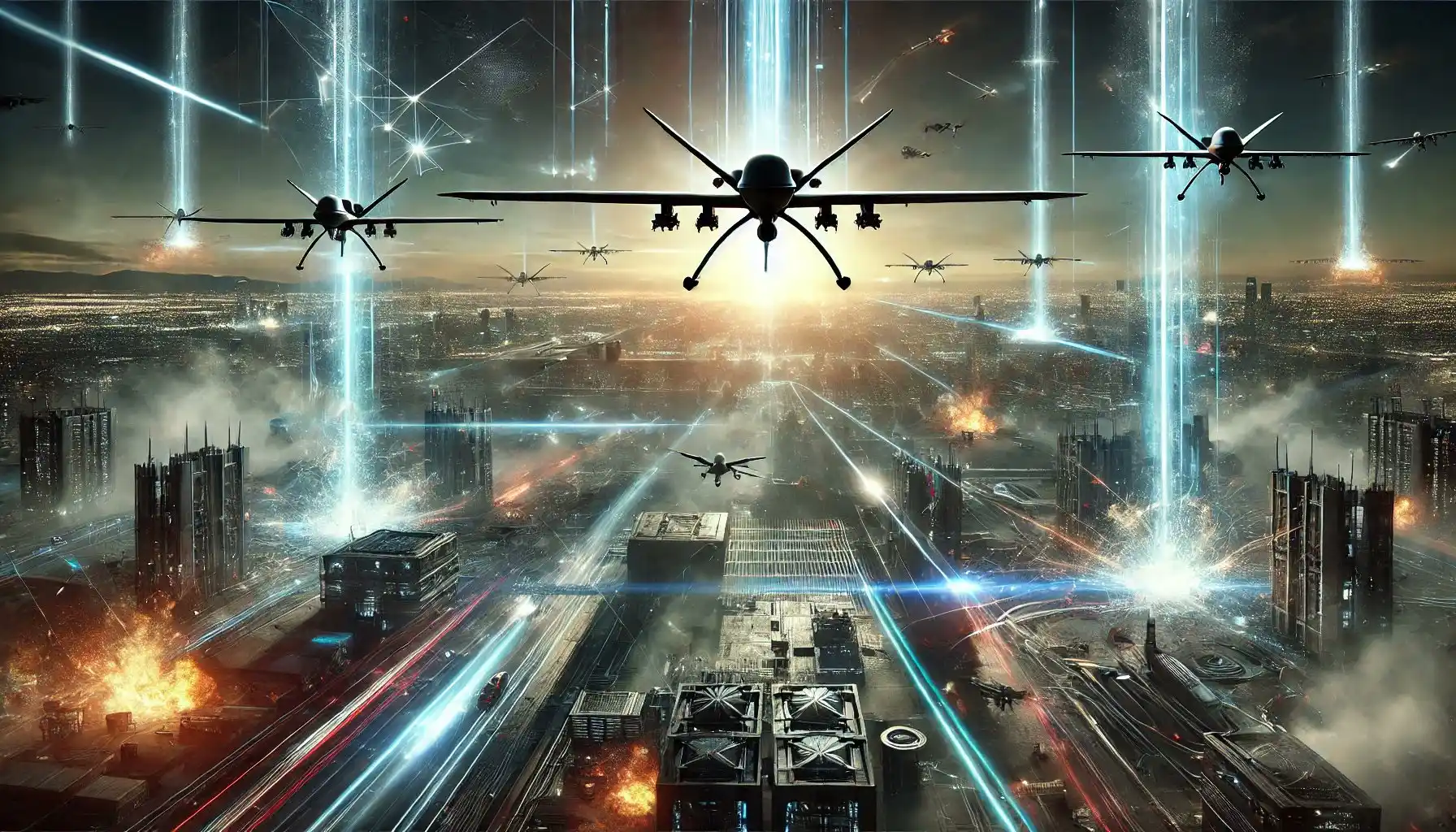
11. The Future of Drone Warfare
The battle for control of the skies is far from over. As technology accelerates, drones are becoming smarter, stealthier, and more autonomous, capable of executing complex missions with minimal human intervention. These advancements have not only reshaped modern warfare but also posed significant challenges to public security and defense. Staying ahead in this rapidly evolving domain demands foresight, innovation, and a commitment to countering threats that seem to emerge faster than solutions can be devised. This chapter explores the trajectory of drone technology and provides a roadmap for crafting the defenses of tomorrow.
11.1.1. Emerging Drone Technologies: The New Era of Autonomy
Drones have evolved beyond the constraints of human operators. Advances in artificial intelligence, machine learning, and materials science are transforming these machines into powerful, independent agents of conflict.
Autonomous Swarms
Strength in Numbers Imagine hundreds of drones operating in perfect unison, each a node in a hive-mind capable of dynamic coordination. Autonomous swarms represent a revolutionary shift in military strategy, leveraging sheer numbers and collective intelligence to outmaneuver conventional defenses.
- Capabilities: These swarms can adjust their formations, split into smaller units, or converge on high-value targets with devastating precision.
- Threat Level: Defending against a single drone is manageable; neutralizing an entire swarm is a monumental challenge. Traditional systems, designed for isolated threats, are ill-equipped for the overwhelming scale of swarm attacks.
- Countermeasures: Scalable defenses are critical. Solutions such as electromagnetic pulse (EMP) systems or AI-driven interceptors capable of engaging multiple drones simultaneously hold promise in countering swarm tactics.
- Stealth Systems: The Invisible Threat Once exclusive to manned aircraft, stealth technology is now a key feature of next-generation drones. With radar-absorbing materials, low-profile designs, and reduced thermal signatures, these UAVs are designed to evade detection.
- Capabilities: Stealth drones can penetrate protected airspace, gather intelligence undetected, or execute precision strikes with minimal risk of exposure.
- Threat Level: Early detection is nearly impossible, increasing the likelihood of successful missions against critical infrastructure or military targets.
Countermeasures: Cutting-edge detection technologies like quantum radar and hyperspectral imaging are essential to mitigate this threat. These systems exploit subtle anomalies in the environment, such as minute shifts in light or electromagnetic fields, to identify stealth drones.
11.1.2. AI Targeting and Decision-Making
AI is pushing drones beyond simple automation, enabling them to operate autonomously in complex, contested environments. With capabilities to identify, prioritize, and engage targets, AI-driven drones are rewriting the rules of engagement.
- Capabilities: AI enables drones to distinguish between decoys and real threats, adapt to countermeasures, and execute missions with surgical precision.
- Threat Level: The absence of human oversight introduces unpredictability, complicating defense strategies and raising ethical concerns.
- Countermeasures: Defensive AI systems must evolve in parallel. Tools like adversarial algorithms, designed to confuse or misdirect AI systems, can neutralize the effectiveness of autonomous targeting.
11.1.3. Adapting to AI-Driven Threats
The rise of AI in drone warfare marks a paradigm shift. Unlike human-controlled systems, AI-powered drones operate with unparalleled speed, precision, and adaptability. Countering these advancements demands innovative strategies and technologies.
11.1.4. Anticipating Drone Behaviour
AI-driven drones learn and adapt, rendering static defenses increasingly vulnerable. Defensive systems must match this adaptability.
- Solution: AI-based countermeasures capable of real-time behavioral analysis are critical. By predicting drone movements, these systems can optimize engagement strategies dynamically.
11.1.5. Enhancing Defensive
- AI The best way to combat AI is with superior AI. Defensive technologies must leverage machine learning to improve accuracy, response times, and situational awareness.
- Example: AI-powered counter-drones can autonomously intercept hostile UAVs, prioritizing high-value threats while conserving resources.
11.1.6. Cybersecurity in the Drone Arena
- Even the most advanced AI-driven drones are vulnerable to cyberattacks. Exploiting software vulnerabilities offers a non-lethal approach to neutralizing threats.
- Approach: Develop cyber tools that intercept communication, disable onboard systems, or hijack control mechanisms. These tools can render a hostile drone inert without resorting to kinetic action.
11.2. Technological Leapfrogging: Staying Ahead in the Arms Race
The arms race in drone technology is relentless. Staying ahead requires constant innovation and a willingness to explore unconventional approaches.
11.2.1. Investing in Research and Development
Ongoing investment in cutting-edge technologies is critical. Key areas of focus include:
- Energy Weapons: Directed energy systems like lasers and microwaves for precision neutralization of drones.
- Biometric Recognition: Advanced systems that identify operators or high-risk UAVs using facial or movement analysis.
- Material Science: New materials that enhance drone resistance or improve protective barriers against UAV threats.
11.2.2. Collaborating Across Sectors
- Public-private partnerships and international cooperation are essential to accelerating progress and pooling resources.
- Example: Joint ventures between defense contractors, universities, and government agencies have already yielded breakthroughs in AI and directed energy weapons.
- Leveraging Predictive Analytics Data-driven insights can anticipate future advancements in drone technology, enabling preemptive development of countermeasures.
- Application: Analyze global trends in drone design, production, and deployment to forecast emerging threats and guide R&D efforts.
Conclusion: The Horizon Ahead
The future of drone warfare presents both a challenge and an opportunity. Emerging technologies are reshaping the skies, pushing the boundaries of what drones can achieve while inspiring innovative defenses. Staying ahead in this arms race requires anticipation, collaboration, and a relentless commitment to adaptation.
Victory in the battle for the skies lies in foresight — anticipating the next move, preparing for evolving realities, and building defenses as dynamic and resilient as the threats they counter. The fight is far from over, but with determination and ingenuity, the skies can remain a domain of security and freedom. The future of drone defense begins now.
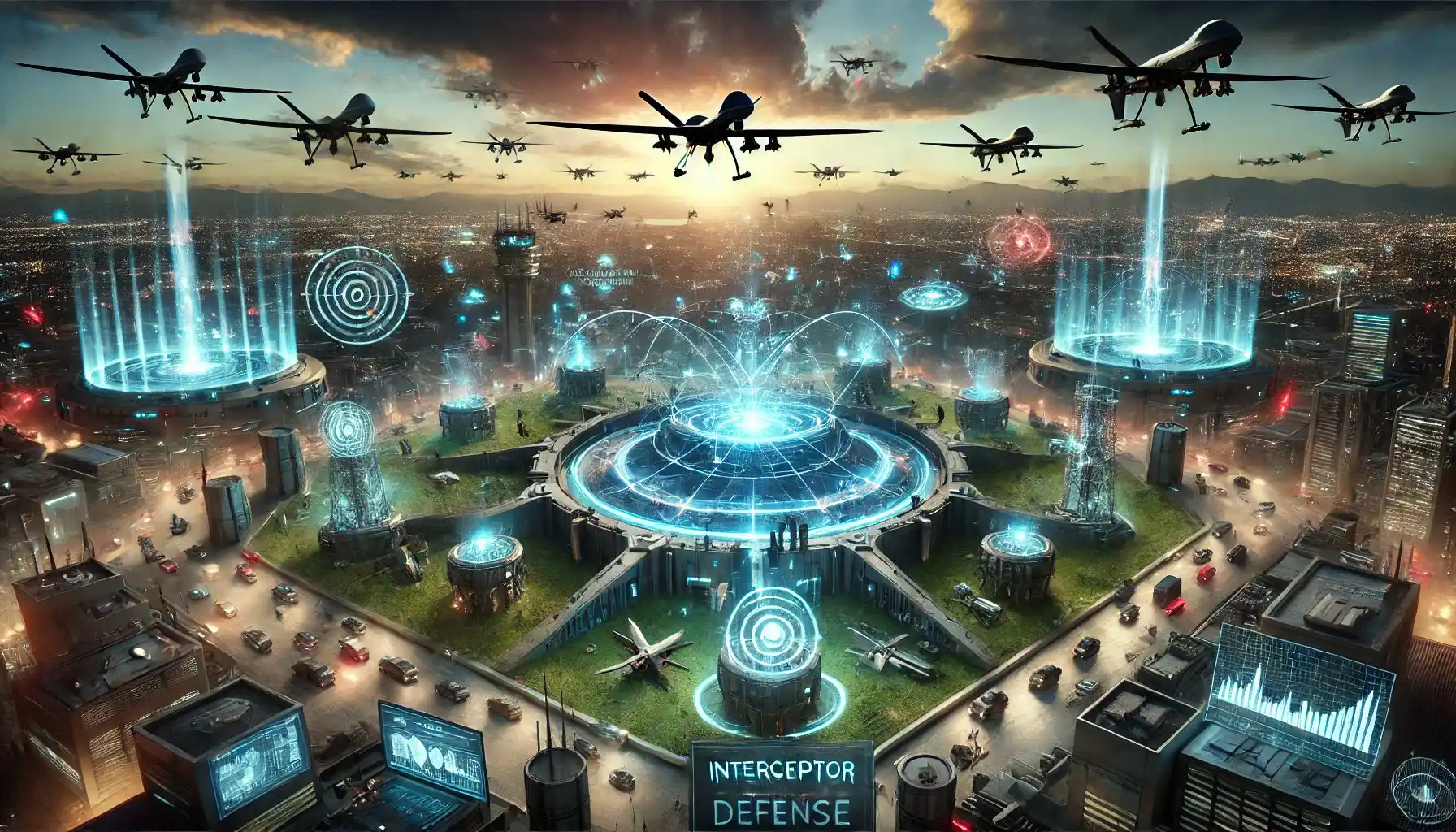
12. Building a Comprehensive Defense System
The fight to reclaim control of the skies from hostile drones is as complex as it is critical. Drone threats have evolved into a multifaceted challenge, requiring a defense system that integrates diverse technologies, strategies, and participants. A truly comprehensive defense system must address immediate needs such as detection and neutralization while also anticipating future advancements in drone technology.
This chapter explores the cornerstone strategies of modern drone defense: the layered defense model, the necessity of cross-sector collaboration, and the forward-thinking approaches required to future-proof against emerging threats.
12.1. The Layered Defense Model: A Multi-Tiered Approach
Imagine a fortress where each layer of defense — from outer walls to inner strongholds — works in harmony to repel an attack. This is the essence of a layered defense model in counter-drone strategy. By integrating tools for detection, disruption, and destruction, defenders create a seamless and adaptive response system capable of neutralizing threats at every stage.
12.1.1. Detection: The First Line of Defense
Detection is the foundation of drone defense, enabling early identification of incoming threats before they can reach critical targets. Advanced systems combine multiple technologies for comprehensive coverage:
- Radar Systems: These detect drones over long distances, particularly at high altitudes or speeds, making them indispensable for wide-area surveillance.
- Acoustic Sensors: Especially effective in urban settings, these identify drones based on their unique sound signatures.
- Optical Systems: High-resolution cameras and infrared sensors confirm drone presence visually, even in low-light conditions.
- AI Analysis: Artificial intelligence automates the classification of threats, distinguishing hostile UAVs from benign or civilian ones with speed and accuracy.
12.1.2. Disruption: Neutralizing Without Destroying
- Disruption tools focus on non-lethal methods to neutralize drones, minimizing collateral damage while enabling forensic recovery of UAVs for intelligence purposes:
- Jamming Technologies: These block communication between drones and their operators, forcing the UAVs into fail-safe modes like hovering or returning to base.
- Electromagnetic Pulse (EMP) Devices: EMPs disable drone electronics without physical destruction, offering an elegant solution for urban or sensitive environments.
- Cyber Tools: Sophisticated hacking methods allow operators to intercept, take control of, or disable drones remotely.
12.1.3. Destruction: The Final Option
12.1.3.1. Tools Capable of Eliminating UAVs
- When disruption fails or the threat is imminent, destruction becomes necessary. This layer employs tools capable of eliminating UAVs with precision:
- Kinetic Weapons: Shotguns, rifles, and missile systems deliver physical blows to neutralize drones effectively.
- Directed Energy Weapons (DEWs): Lasers and similar systems disable drones with pinpoint accuracy and minimal collateral impact.
- Interceptor Drones: These specialized UAVs physically collide with or capture hostile drones mid-air, neutralizing them before they reach their targets.
12.1.3.2. Integration of Layers
The true power of a layered defense system lies in its integration. For example, radar systems detect an incoming drone and classify it as hostile. Jammers attempt to disrupt its communication, and if disruption fails, kinetic weapons or directed energy systems engage to eliminate the threat. Each component communicates seamlessly, ensuring rapid and coordinated responses.
12.2. Cross-Sector Collaboration: A Unified Front
The scale and complexity of drone threats demand collaboration across sectors. No single entity — military, civilian, or private — can address the challenge alone. By working together, these sectors can build a robust and adaptable defense system.
12.2.1. Civilian Involvement
Communities often form the first line of defense in urban areas where airspace is contested. Their role includes:
- Awareness Campaigns: Educating the public about identifying and reporting suspicious drone activity.
- Local Defense Networks: Providing portable detection tools such as acoustic sensors or mobile apps for real-time reporting.
- Private Sector Contributions The private sector is a vital driver of innovation, with companies specializing in robotics, artificial intelligence, and telecommunications contributing advanced counter-drone technologies. Examples include:
- Technology Development: Creating bespoke solutions such as AI-driven detection and defense systems.
- Infrastructure Protection: Implementing customized defenses for power plants, airports, and other critical facilities.
12.2.3. Government and Military
Leadership Governments and militaries provide the overarching framework necessary for successful collaboration:
- Policy and Regulation: Establishing guidelines that balance security with civil liberties.
- Funding and Resources: Allocating resources for research and development to maintain a technological edge.
- International Cooperation: Sharing intelligence and best practices with allies to counter global threats.
12.3. Future-Proofing Strategies: Adapting to the Unknown
The evolution of drone technology is relentless, with advancements occurring faster than ever. Future-proofing requires defenders to anticipate these developments and adapt accordingly.
12.3.1. Embrace Emerging Technologies
To stay ahead, defenders must proactively adopt cutting-edge tools and techniques:
- Quantum Radar: Capable of detecting even stealth-enabled drones by countering evasion tactics.
- AI-Driven Defense Networks: Leveraging machine learning to predict drone behavior and optimize countermeasures.
- Next-Generation Jamming: Developing adaptive systems that can counter frequency-hopping or fully autonomous drones.
12.3.2. Foster a Culture of Innovation
Continuous experimentation and adaptation are essential:
- Test Environments: Simulation spaces allow for the safe testing of new technologies and strategies.
- Collaborative Research: Partnerships with academic institutions and think tanks encourage the exploration of unconventional ideas.
12.3.3. Monitor and Analyze Trends
Staying informed about global drone developments is critical:
- Intelligence Gathering: Tracking advancements in drone design and usage patterns.
- Data-Driven Insights: Analyzing past engagements to refine strategies and improve system performance.
12.4. Conclusion: Securing the Skies Together
Building a comprehensive defense system is not a one-time endeavour. It is a continuous journey of collaboration, innovation, and adaptation. By embracing a layered defense model, fostering cross-sector partnerships, and preparing for the unknown, we can create a future where the skies remain secure.
The battle for control of the skies is one of the defining challenges of our time. Through shared knowledge, advanced technology, and unwavering resolve, we can reclaim the airspace and safeguard our collective future. Together, we will ensure that no adversary — no matter how sophisticated — can dominate the skies. Victory is within reach, but only if we work as one.
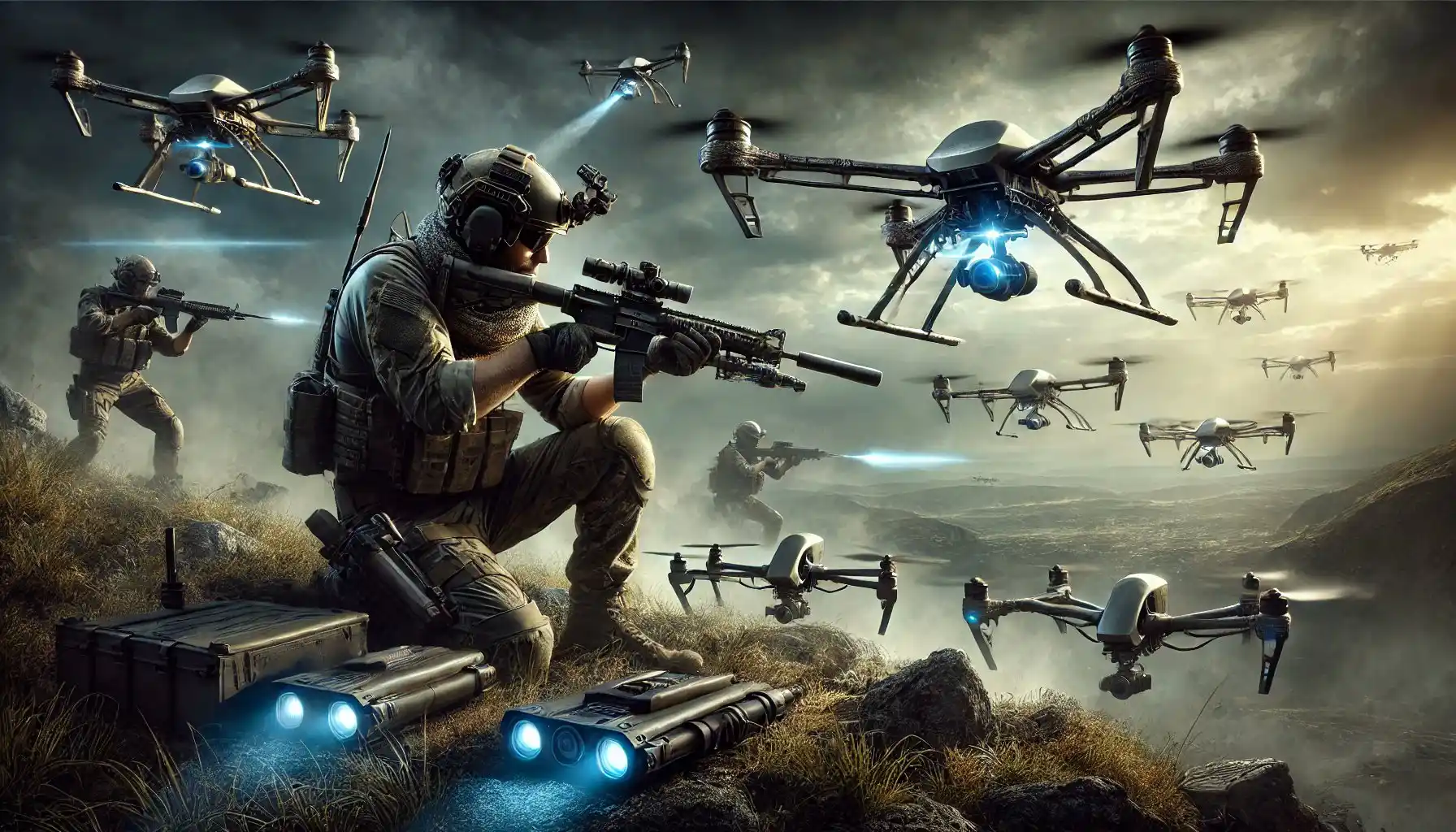
12.5. “Guardians of the Skies: A Vision for Drones as Humanity’s Partners”
This book has journeyed through the labyrinth of drone technology, unearthing its dual nature as both a peril and a promise. It began as a study of immediate challenges — misuse, surveillance, and weaponization — but has evolved into a manifesto for human ingenuity. The path forward lies not in rejecting this technology but in reclaiming it as an ally in humanity’s quest for security, resilience, and progress.
12.6. The Present: Lessons from the Skies
The story of drones is one of transformation. What began as tools of exploration now shapes the contours of conflict, ethics, and governance. Their rise has redefined warfare, exposing vulnerabilities and challenging traditional defenses. But amidst these risks lies a profound opportunity: the chance to build layered defenses that protect without compromising freedom, to innovate responsibly, and to unite nations under shared ethical standards.
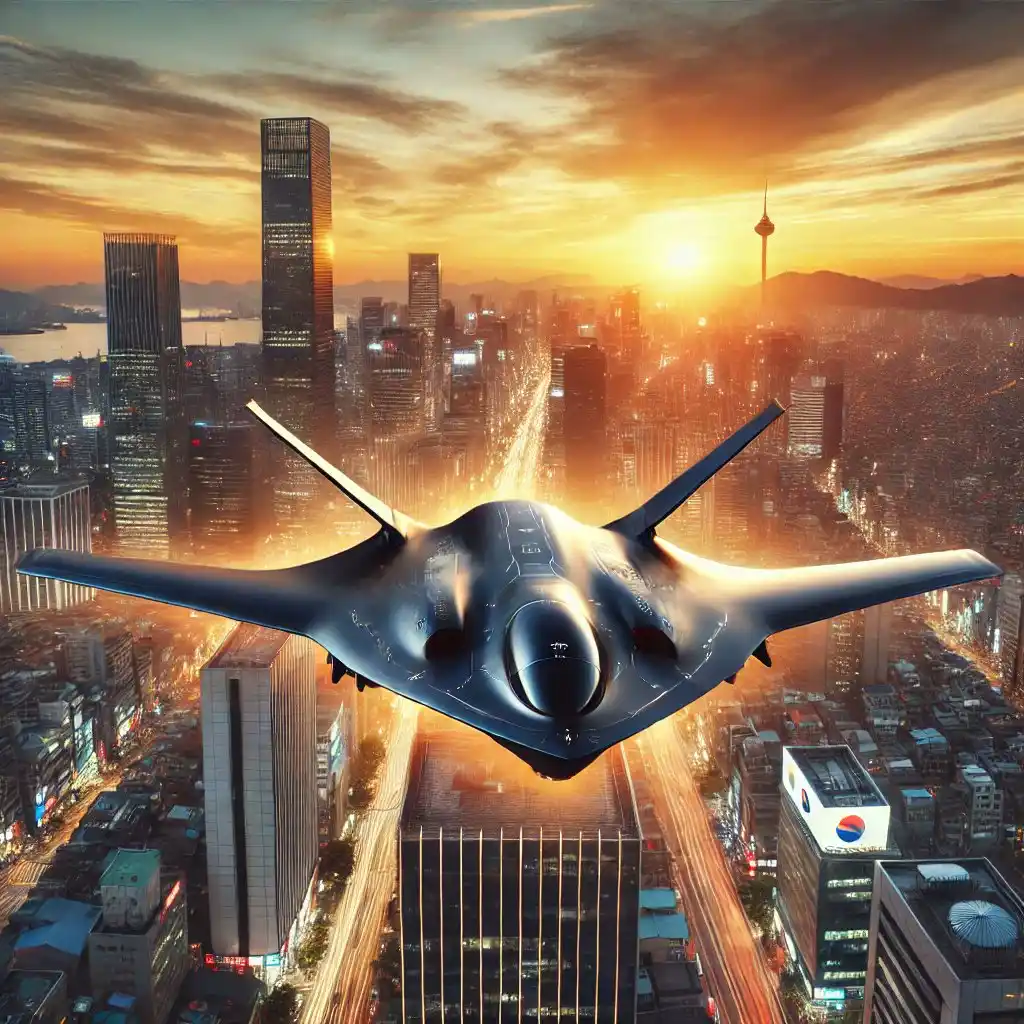
12.7 The Bridge to the Future: Stewardship and Vision
Drones are not inherently good or evil; they are mirrors of human intent. In their duality lies the potential to either divide or unite, harm or heal. Humanity must navigate this duality with wisdom and courage, shifting from reactive defense to proactive guardianship. This requires a philosophy of stewardship — an acknowledgment that the skies are not just contested spaces but shared realms of limitless potential.
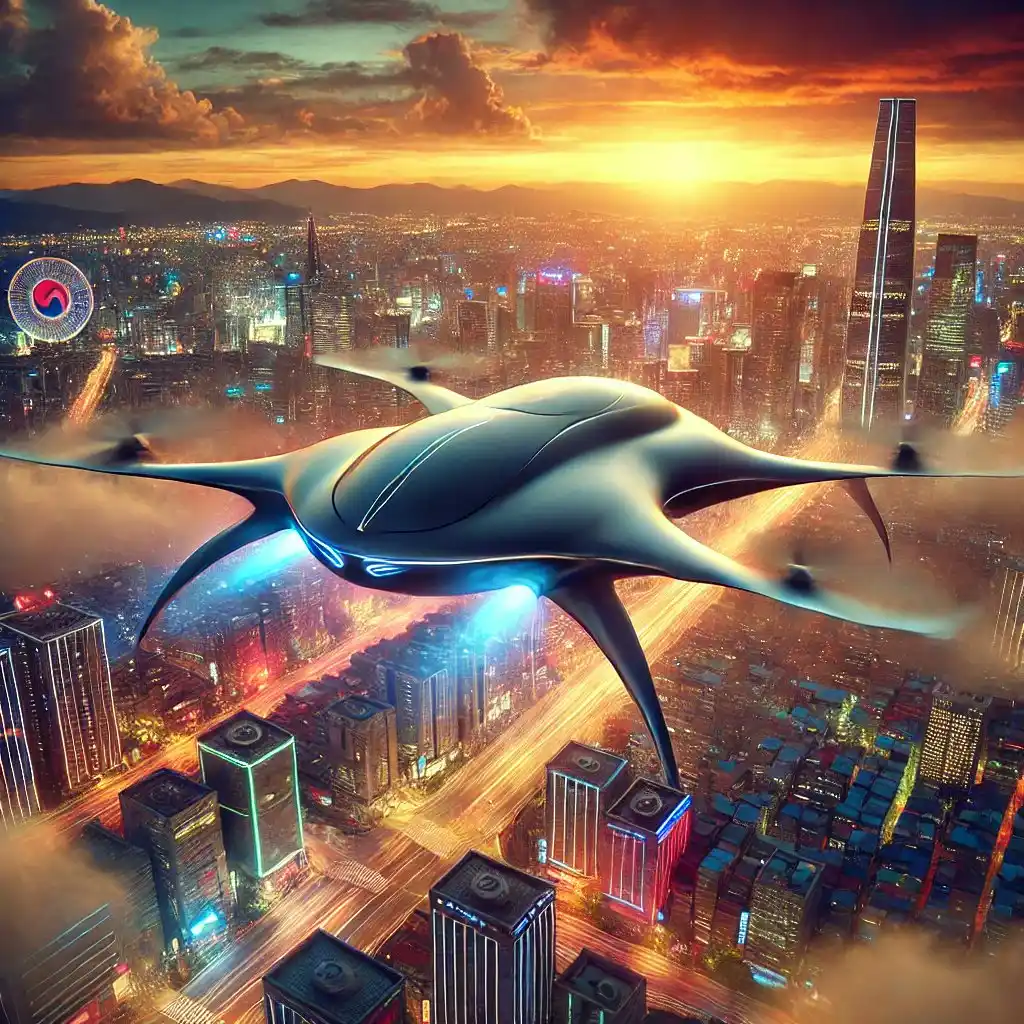
13. The Vision: Drones as Humanity’s Guardians
Imagine skies filled with guardian drones, their hum a symbol of solidarity and protection. These sentinels patrol disaster zones, deliver aid, and restore connections. They monitor ecosystems, defend biodiversity, and combat illegal activities. They bridge gaps in healthcare and communication, empowering under-served communities to thrive. Guided by ethical AI and robust governance, they reflect humanity’s highest aspirations.
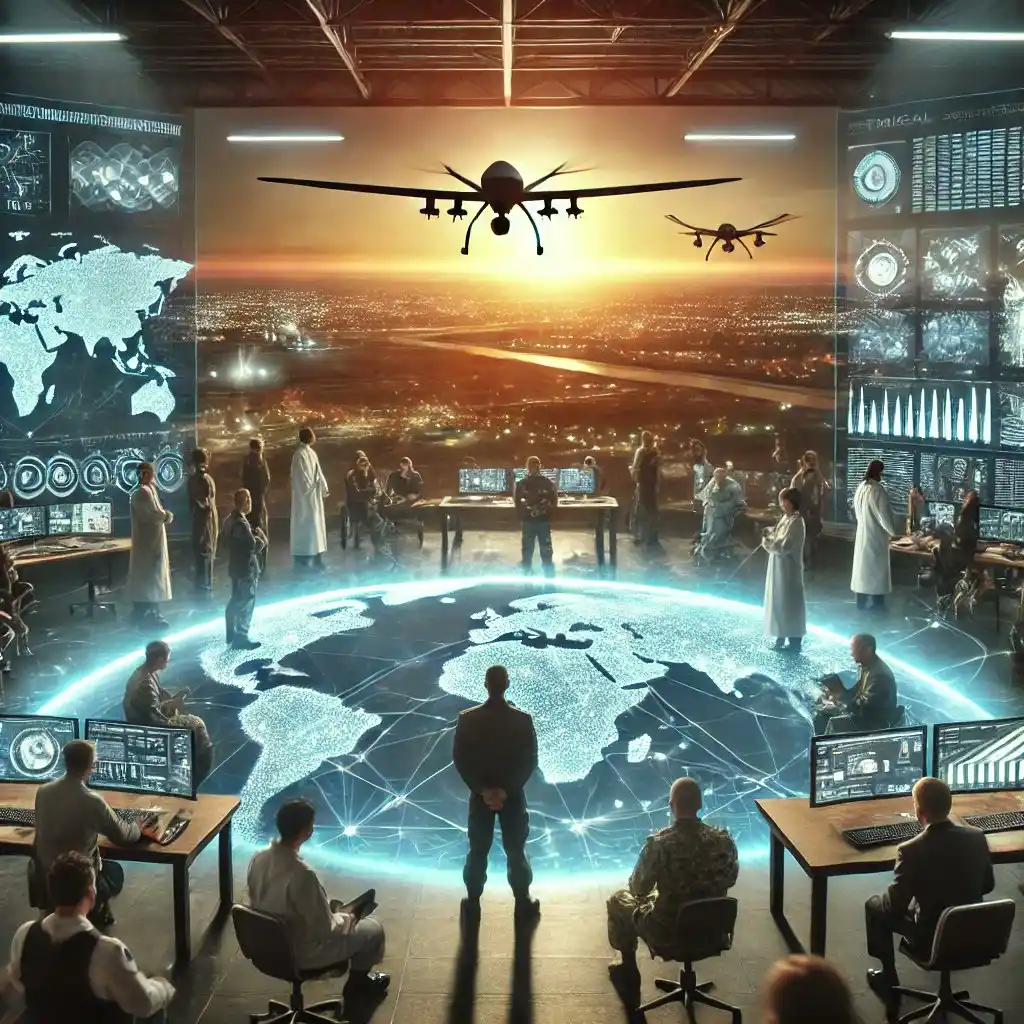
14. The Call to Action: Building Resilience Together
The battle for the skies is not just technological; it is a societal challenge. To succeed, we must:
- Collaborate globally, uniting governments, industries, and citizens.
- Foster innovation, anticipating future threats while unlocking transformative applications.
- Empower communities through education, democratizing access to drone technologies.
- Embed ethical principles in every algorithm, ensuring transparency and accountability.
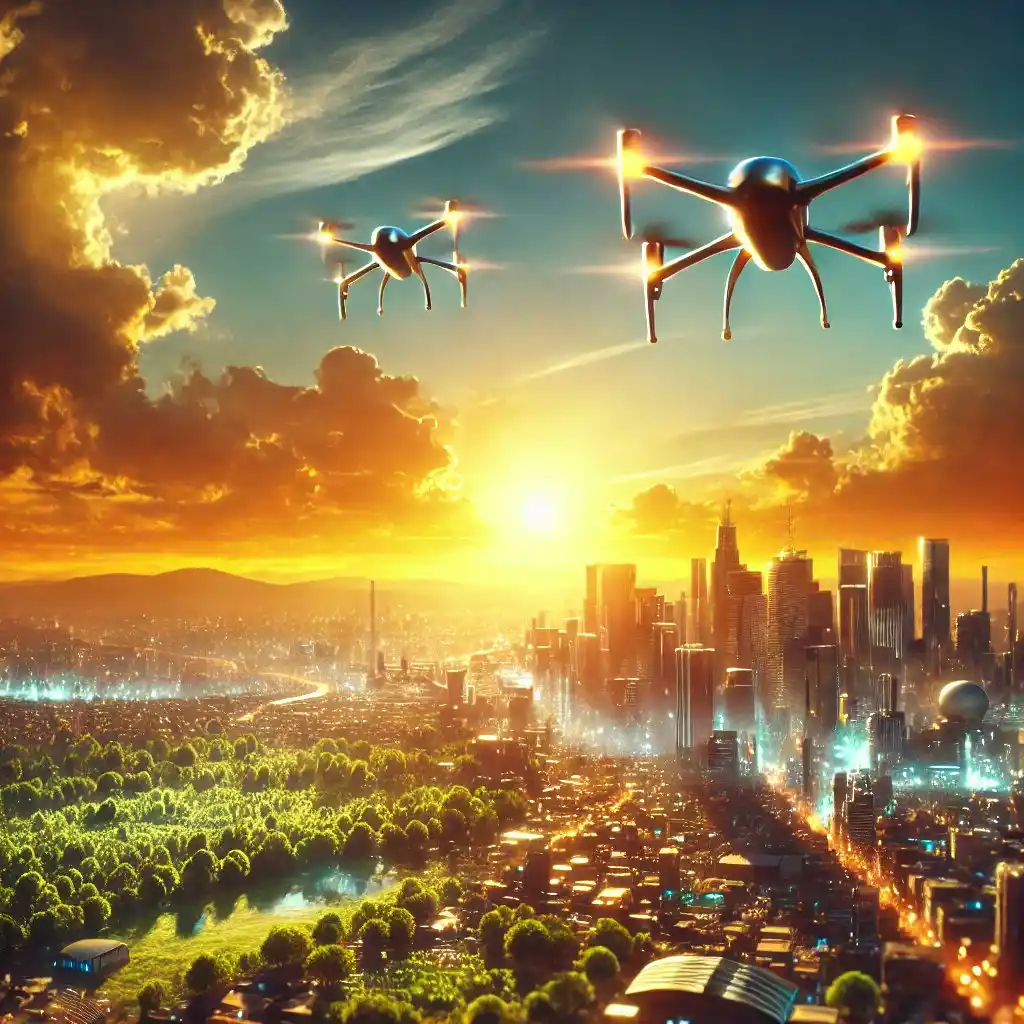
15. The Legacy: Reclaiming the Skies
The skies are vast, limitless, and full of promise. They remind us of our ability to dream and achieve. As we reclaim them, let us do so not with fear but with hope. Let us ensure that drones serve as tools of empowerment, not oppression — as guardians of human dignity, resilience, and shared progress. Together, we can secure a future where technology is an ally, not an adversary — a future where the hum of drones signals not conflict but the harmony of human potential taking flight.

16. Appendix: Tools, Terms, and Training for Drone Defense
In any battle, understanding the tools, tactics, and terminology is fundamental to success. This appendix provides a deep dive into the key concepts, technologies, and training frameworks that underpin effective drone defense strategies. From breaking down critical definitions to exploring structured training for diverse operators, these sections are designed to enhance comprehension and provide actionable insights.
17. Glossary of Terms: Drone and Defense Terminology
The terminology of drone defense can be technical and nuanced. This glossary provides concise definitions to help readers navigate the book and apply its concepts effectively
Drone Types
- Quadcopter: A lightweight, four-rotor UAV known for its agility and widespread use in surveillance, photography, and small payload delivery.
- PV (First Person View) Drone: A small UAV controlled via a real-time video feed, often used for reconnaissance or racing due to its speed and maneuverability.
- UAV (Unmanned Aerial Vehicle): An umbrella term for any aerial vehicle without an onboard human pilot, encompassing both civilian and military drones.
- VTOL (Vertical Takeoff and Landing): UAVs capable of vertical liftoff and landing, commonly employed in logistics and military operations for their flexibility.
Technologies
- AI-Driven Targeting: Systems leveraging artificial intelligence to autonomously identify, prioritize, and engage targets based on predefined criteria.
- Electromagnetic Pulse (EMP): A burst of electromagnetic energy used to disable electronic systems by overloading their circuits.
- Jammer: A device designed to disrupt communication signals between drones and their operators, rendering the UAV inoperable.
- Directed Energy Weapon (DEW): High-precision systems that use focused energy, such as lasers or microwaves, to neutralize drones.
Tactics and Systems
- Layered Defense: A comprehensive approach that integrates detection, disruption, and destruction technologies to counter drone threats effectively.
- Counter-Drone Jammer: Specialized devices that interrupt a UAV’s control signals, forcing it to return to base or crash.
- Interceptor Drone: A UAV designed to engage and neutralize hostile drones in mid-flight through collision or disabling maneuvers.
- MANPADS (Man-Portable Air Defense Systems): Lightweight, shoulder-fired missile systems capable of engaging drones and other aerial threats.
Key Concepts
- Payload: The equipment or cargo carried by a drone, including cameras, sensors, or weaponry.
- Stopping Power: The ability of a weapon or countermeasure to neutralize a target effectively.
- Autonomous Swarm: Multiple drones working collaboratively without human oversight, using algorithms to coordinate their movements and actions.
Diagrams and Schematics: Visualizing Defense Strategies
Understanding drone vulnerabilities and defensive strategies is enhanced through visual representation. Below are key concepts translated into diagrams to aid comprehension.
Drone Weak Points
- Quadcopter:
- Rotor Assembly: Critical for flight; disabling this component grounds the drone.
- Central Frame: Houses the drone’s control units and batteries.
- Optical Sensors: Enable navigation and surveillance.
- Medium UAV:
- Engine and Propulsion Systems: Targeting these components immobilizes the drone.
- Payload Compartments: Disrupting these areas renders payload delivery ineffective.
- Cameras and Radar: Neutralizing these systems blinds the drone’s reconnaissance capabilities.
- Large UAV:
- Rotor and Wing Joints: Structural points critical for maintaining stability.
- Optical and Targeting Sensors: Disabling these limits offensive accuracy.
- Armament Bays: Neutralizing these prevents offensive actions.
- Engagement Zones
• Close Range (0 – 50 meters): Shotguns and birdshot are effective against small drones.
• Mid-Range (50 – 300 meters): Employ rifles with full-metal jacket (FMJ) rounds for medium UAVs.
• Long Range (300 – 600 meters): Use high-caliber rifles or MANPADS for large, armoured UAVs.
Layered Defense Setup
1. Outer Perimeter:
- Detection Systems: Radar and thermal imaging provide early warnings.
- Long-Range Engagement: MANPADS and high-caliber rifles counter threats at distance.
2. Intermediate Zone:
- Jammers and DEWs: Disrupt or neutralize incoming threats.
- Counter-Drone UAVs: Intercept and neutralize drones in mid-flight.
3. Inner Perimeter:
- Short-Range Defenses: Use shotguns and compact rifles for immediate threats.
Training Frameworks: Tailored Plans for Diverse Operators
Training is the cornerstone of effective drone defense. The following frameworks provide structured plans for civilian, military, and hybrid operators to enhance readiness and response capabilities.
Civilian Operators
- Objective: Empower individuals to protect homes and communities from small drone threats.
- Core Skills:
- Shotgun Marksmanship: Train with birdshot for engaging drones at close range.
- Quick Response Drills: Simulate sudden drone incursions for rapid reaction.
- Basic Jamming Operations: Learn to deploy handheld jammers effectively.
- Recommended Equipment:
- 12-Gauge Shotgun, Handheld Jammer, Protective Eyewear.
Military Personnel
- Objective: Prepare soldiers to counter dynamic drone threats in combat zones.
- Core Skills:
- Precision Shooting: Train with rifles to target UAV weak points effectively.
- Tactical Transition Drills: Master seamless weapon transitions under pressure.
- Advanced Jamming: Operate vehicle-mounted or stationary jammers.
- Coordination Exercises: Establish and execute layered defense strategies.
- Recommended Equipment:
- .308 Battle Rifle, MANPADS, Counter-Drone UAVs.
Hybrid Operators (Private Security and Critical Infrastructure Defenders)
Objective: Equip operators to defend high-value assets and critical infrastructure.
- Core Skills:
- Situational Awareness: Train to recognize and evaluate drone threats early.
- Escalation Protocols: Determine when to use non-lethal versus lethal measures.
- Integrated System Use: Operate AI-driven counter-drones and DEWs effectively.
- Recommended Equipment:
AI Counter-Drone System, Jammer Array, .50 BMG Rifle.
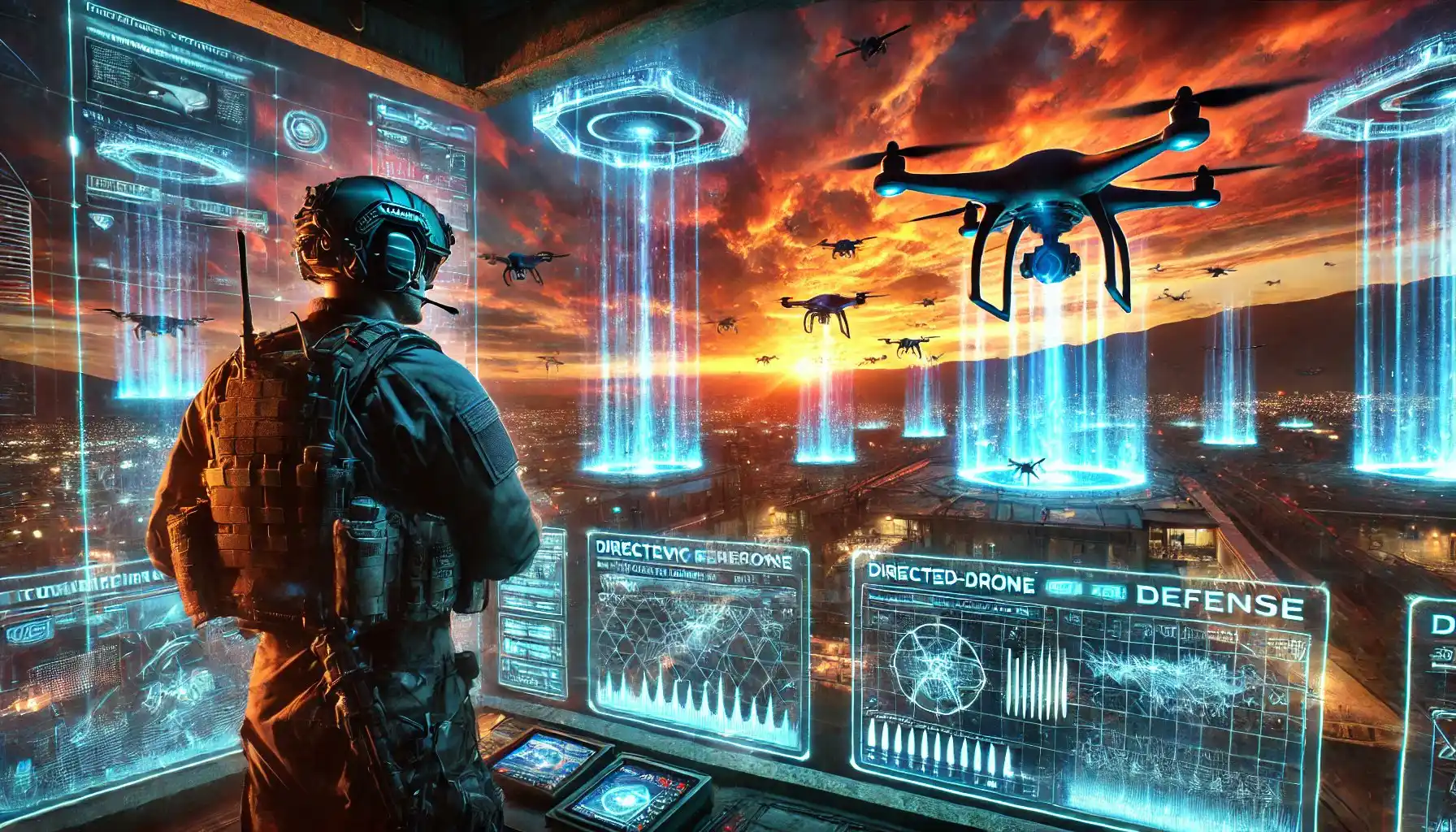
18. Conclusion
This appendix serves as both a reference and a guide, translating complex concepts into actionable knowledge. Whether defending a civilian neighbourhood, a military outpost, or a corporate facility, understanding the tools, tactics, and technologies of drone defense is essential to reclaiming control of the skies. The battle against drones is as much about preparation as it is about execution, and these resources provide the foundation for success.
19. Related Content:
Title: “The AI Gatekeepers: How Tech Companies Shape Human Communication” https://x.com/SkillsGapTrain/status/1862716965694878167
Title: “Blue Storm Rising: The Quiet Force Within” https://x.com/SkillsGapTrain/status/1862255032697045310
Title: “The Timeless Role of Warriors: Guardians of Society, Leadership, & Change” https://x.com/SkillsGapTrain/status/1861728453940351440
Title: “Meshtastic Unveiled: Revolutionizing Decentralized Communication for a Resilient Future” https://x.com/SkillsGapTrain/status/1861416491746226458
Title: “Project Arctic Arrow: Securing NATO’s Sovereignty with Transoceanic Aerospace Innovation from SpaceX” https://x.com/SkillsGapTrain/status/1857500853453603278
Title: “The Return of the Arrow: Canada’s Next Generation Hybrid Ground-Effect Missile for the 21st Century” https://x.com/SkillsGapTrain/status/1857466940152741997
Title: “Human and Autonomous Synergy in Modern Warfare: Strategic Solutions for Canada’s Defense Vulnerabilities” https://x.com/SkillsGapTrain/status/1856124770317734244
Title: “Mastering LoRa Technology and IoT Solutions with LILYGO Devices” https://x.com/SkillsGapTrain/status/1846462658662617488
Title: “Designing the 21st Century “Enterprise”: A Fusion of SpaceX Starships and Sci-Fi Vision” https://x.com/SkillsGapTrain/status/1845405324699668740
Title: “Creating Worlds: How the Genesis Sphere Brings Life to Star Systems” https://x.com/SkillsGapTrain/status/1845170029526175749
Title: “The Universal Language of Knowledge: AI, Censorship, & the Future of Technological Progress” https://x.com/SkillsGapTrain/status/1855229889068068912
Title: “Beyond Aspirations: The Reality of Humanity’s Journey to Multi-Planetary Status” https://x.com/SkillsGapTrain/status/1852240085049094380
Title: “Designing the Superior Fighting Force for the 21st Century: Integrating Blockchain Technology, Artificial Intelligence, Engineering Innovations, & Modern Military Strategies” https://x.com/SkillsGapTrain/status/1844981829750665720
Title: “Comprehensive Analysis of Romania and Hungary’s Positioning in the Fourth Industrial Revolution” https://x.com/SkillsGapTrain/status/1855198708842852392
Title: “Rediscovering Balance: Autonomy and Control in the Age of AI” https://x.com/SkillsGapTrain/status/1844696127012065791
Title: “The Alarming Vulnerability of Security Systems: A Historical Analysis and Urgent Call for Quantum Blockchain and AI Safety Investments” https://x.com/SkillsGapTrain/status/1844534402602193403
Title: “Defending Team Human: Boeing’s Opportunity to Lead Humanity Toward a Thriving Future” https://x.com/SkillsGapTrain/status/1861034898007449712
Title: “Beyond EVs: Top 10 Revolutionary Vehicle Technologies for a Sustainable and Innovative Future” https://x.com/SkillsGapTrain/status/1842412739064410158
Title: “Sector 001: The Terra Nexus for Humanity’s Resilient and Decentralized Future” https://x.com/SkillsGapTrain/status/1833200645089669186
Title: “Canada’s Public Sector vs. Corporate Giants: A Comparative Study of Efficiency and Employee Ratios” https://x.com/SkillsGapTrain/status/1831216630665474467
Title: “Next-Gen Abrams Tank: Revolutionizing Battlefield Dominance with Sequential Firing, Layered Defense, Advanced Composite Armour, Razor Blade Shields, Active Countermeasures, Hybrid Power, Modular Design, and AI Targeting” https://x.com/SkillsGapTrain/status/1826917592822403135
Title: “The Digital Balkanization of Canada: How Trudeau’s Technophobic Neglect is Fracturing the Nation” https://x.com/SkillsGapTrain/status/1825340868586287285
Title: “Transforming Government Efficiency: A Standardized Approach” https://x.com/SkillsGapTrain/status/1820203345761702093
Title: “Comment for Lex Fridman and Elon Musk on Establishing a “Government Efficiency Commission” https://x.com/SkillsGapTrain/status/1819751611964510220
Title: “Towards a Sustainable Future: Integrating Hydrogen, CNG, and Electric Vehicles in Modern Transportation” https://x.com/SkillsGapTrain/status/1818158056431141236
Title: “Enhancing Vehicle Efficiency Through Weight Reduction and Natural Gas Hybrid Systems” https://x.com/SkillsGapTrain/status/1817313442212065628
Title: “Building the Future: How the X Building Redefines Modern Architecture with Pyramid Principle” https://x.com/SkillsGapTrain/status/1823654698680779231
Title: “Engineering the Future: Leveraging the NVIDIA Developer Program and Deep Learning Institute for a Positive Tech Vision” https://x.com/SkillsGapTrain/status/1814141111599800621
Report: “Economic Impact of Blocking Resource and Energy Sectors in Canada” https://x.com/SkillsGapTrain/status/1813138214078619961
Title: “Should Elon Musk Build the Flying Metal Suit of Armour? A Resounding Yes.” https://x.com/SkillsGapTrain/status/1812741316276552174
Title: “Unleashing the Power of AI: Advanced Scientific Reasoning with LLaMA 3 400B+” https://x.com/SkillsGapTrain/status/1814922921594241371
Title: “Building a Secure & Decentralized Internet: Decentralizing the Internet for Enhanced AI Safety” https://x.com/SkillsGapTrain/status/1814735821804876064
Title: “Strategic Deployment of Lightweight Tactical Vehicles in Canadian Shipbuilding Port Cities” https://x.com/SkillsGapTrain/ status/1815830215098278382
Title: “Engineering the Moon into a New Earth: A Positive Tech Vision for Sustainable Space Colonization and Engineering The Next Generation” https://x.com/SkillsGapTrain/status/1815251853602340986
Title: “Design Proposal for an Armoured and Adventure-Ready Tesla Roadster” https://x.com/SkillsGapTrain/status/1844435443372232976
Title: “The Ring of AI, Hope, Freedom & Fire: AeroSpaceX Vanguard, Aegis XXR, & Dawn of Autonomous Dominance” https:// x.com/SkillsGapTrain/status/1860698877210554825
Title: “From Science Fiction to Science Reality: Crafting a Humanity-Centric AGI Future” https://x.com/SkillsGapTrain/status/1860214722949190008
Title: “Being a Warrior Is More Than a Role — It’s a Calling” https://x.com/SkillsGapTrain/status/1858220839092605106
SGT Military Page: https://skillsgaptrainer.com/category/military-science/
Title: “Elton John – Sacrifice” https://youtu.be/NrLkTZrPZA4?feature=shared
To see our Donate Page, click https://skillsgaptrainer.com/donate
